This guide initially displays common arthropods (insects, arachnids, centipedes/millipedes and crustaceans) of all shapes. Use the selectors below to include rare species, select by shape, or search by name.
Arthropods include several different classes: hexapods, arachnids, myriapods and crustaceans. An arthropod is an invertebrate animal with bilateral symmetry, an external skeleton, a segmented body, and jointed appendages arranged in pairs. In order to grow, arthropods have to molt, shedding their whole exoskeleton all at once.
Insects, which comprise the vast majority of hexopods, all have three basic body parts. The head has compound eyes, mouthparts, and antennae that are used as sensory organs. The thorax or mid-section typically has two pairs of wings, if the insect can fly, and three pairs of legs for a total of six. The abdomen contains the insect’s digestive system, reproductive organs and sting organs, if present.
While spiders make up the largest group of arachnids, others in the class include scorpions, harvestmen, ticks, mites, pseudoscorpions and solifuges. Arachnids have eight legs plus two additional pairs of appendages: chelicerae used for feeding and defense and pedipalps which function as a sensory organ or in reproduction. Arachnids do not have antennae or wings and have two main body parts with the head and thorax fused into one. In addition, they have two different types of eyes for a total of eight.
Centipedes and millipedes make up most of the myriapod species. They are best known for their long, segmented bodies with multiple legs, though far fewer than their names imply. In addition, they have a single pair of antennae, simple eyes, and mouthparts on the underside of their bodies.
Most crustaceans are free-living aquatic animals but a few are terrestrial such as the woodlice. Their bodies are composed of segments that are grouped into three regions: head, thorax and abdomen. Each body segment may have one or more pairs of appendages which serve as antennae, mandibles, maxillae, legs and tail.
Over 80% of all living animal species are arthropods. They occupy all kinds of roles: predators, prey, parasites, hosts, herbivores and decomposers and live in all different types of habitats. Many are particularly adapted to life in a dry environments like that of Southwest. This guide focuses on many of the common arthropods in the greater Los Alamos area. However, please note that insects in the Lepidoptera order are discussed separately in the Butterfly and Moth Guide.
Insect, Spider and Kin References
A Checklist of Plant and Animal Species at Los Alamos National Laboratory and Surrounding Areas
A Guide to Arthropods Bandelier National Monument, National Park Service [PDF]
American Arachnological Society
Arnett, RH, Jr. 2000 American Insects: A Handbook of the Insects of America North of Mexico CRC Press
BugGuide.Net
Encyclopedia of Life
Field Guide to Insects and Diseases of Arizona and New Mexico Forests, US Forest Service [PDF]
Grasswitz, T.R. and Dressen, D.R. Pocket Guide to the Native Bees of New Mexico [PDF]
Grasswitz, T.R. and Dressen, D.R. Pocket Guide to the Beneficial Insects of New Mexico [PDF]
A Manual of Grasshoppers of New Mexico
iNaturalist
Insect Identification, New Mexico
Mackay, W. and Mackay, E., 2001 The Ants of New Mexico (Hymenoptera: Formicidae) [PDF]
Museum of Southwestern Biology
New Mexico Spiders
Odonata Central
One Hundred Common Insects of New Mexico, NM State University [PDF]
Sanborn, A.F. and Phillips, P.K., 2013 Biogeography of the Cicadas (Hemiptera: Cicadidae) of North America, North of Mexico [PDF]
Symbiota Collections of Arthropods Network
Sutherland, C.A. Rove Beetles [PDF]
Symbiota Collections of Arthropods Network
Ticks and Tick Borne Diseases
Wildlife Notes – Centipedes and Millipedes [PDF]
Subject Area Experts (all guides)
Steve Cary (butterflies)
Beth Cortright (insects)
Terry Foxx (invasive plants)
Leslie Hansen (mammals)
Richard Hansen (fish, mammals)
Dorothy Hoard (butterflies, trees)
Chick Keller (flowers, herbarium)
Shari Kelley (geology)
Kirt Kempter (geology)
Garth Tietjen (reptiles)
David Yeamans (birds)
Web Development and Content Management
Pat Bacha
Jennifer Macke
Graham Mark
Akkana Peck
Contact
Please contact us for local nature questions and sightings. We welcome comments, corrections, and additions to our guides.
For more information about local nature, please visit our Nature Blog or subscribe to PEEC This Week.
Make Selection
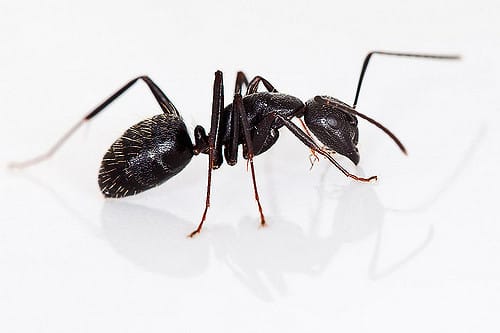  Photo: Dmitry Mozzherin |          Carpenter Ant(Camponotus spp., Formicidae family)Order: Hymenoptera (Ants, Bees and Wasps) Size: 0.3 - 1 in (8 - 25 mm) Distinguishing Features: large, broad head with thin waist; highly variable in overall size Status: native; common Habitat: nests in logs and stumps under trees but can invade homes. The genus Camponotus contains a very large number of species known collectively as Carpenter Ants. One of the most common US species associated with human habitation is the black carpenter ant (Camponotus pennsylvanicus). Though these ants chew out areas inside wood for their nests, they do not eat it. They usually feed on seeds but still can cause structural damage in a home. These ants bite but do not sting. Info Photos |
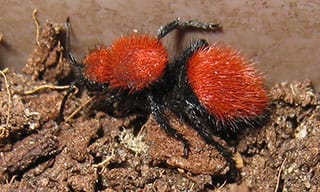  Photo: Jennifer Macke |          Velvet Ant, Cow Killer(Dasymutilla spp., Mutillidae family)Order: Hymenoptera (Ants, Bees and Wasps) Size: 0.8 - 0.9 in (19 - 22 mm) Distinguishing Features: ant-like with only a slight constriction between the the thorax and abdomen; usually red or orange, but may also be yellow or white; covered with obvious hair; males are winged; females wingless Status: native; uncommon Habitat: arid and semiarid open lands These hairy wasps move quickly along the ground and are often mistaken for ants. They can make a squeaking noise by rubbing their abdominal segments together. Males do not sting, but females can deliver a very painful sting, giving velvet ants the nickname of Cow Killer. Larvae are external parasites to various types of other Hymenoptera, such as ground-nesting bees. Info Photos |
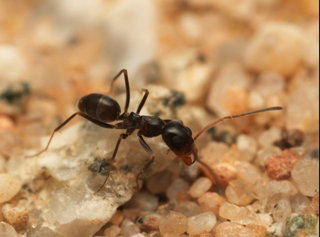  Photo: Jesse Rorabaugh 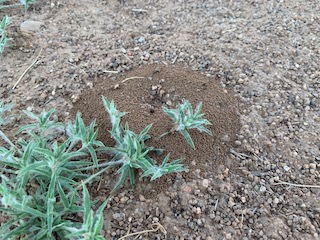  Photo: Mound created by crazy ants. The surrounding pebbles are part of a nearby harvester ant mound. by Jennifer Macke |          Crazy Ant, Crazy Pyramid Ant, Pyramid Ant(Dorymyrmex insanus)Order: Hymenoptera (Ants, Bees and Wasps) Size: up to 0.1 in (2 mm) Distinguishing Features: small; dark brown; large eyes; distinctive nest with a small mound of dirt Status: native; common Habitat: open sunny areas A small ant that is often overlooked, but very common. It is especially common in disturbed soil in hot arid places. It is recognized by its small mound nests, about 4 inches in diameter, and by its behavior. If you disturb the nest, the ants run around frantically, giving it the common name "crazy ant". Its mound nests often appear in the cracks in sidewalks and around the perimeter of harvester ant mounds (especially P. rugosus and P. occidentalis). The crazy ants and harvester ants appear to coexist well. Info Photos |
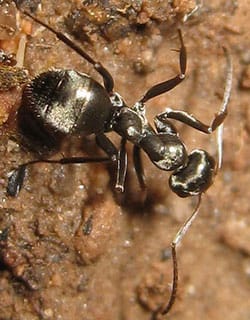  Photo: Jennifer Macke |          Black Lawn Ant(Formica podzolica, Formicinae family)Order: Hymenoptera (Ants, Bees and Wasps) Size: 0.2 - 0.3 in (4 - 8 mm) Distinguishing Features: abdomen is somewhat reflective, giving the illusion of a white band Status: native; common Habitat: yards and wooded areas Often live under rocks in landscaped areas though may be found in coniferous forests where their mounds are covered by herbaceous plants. They feed on dead invertebrates and nectar. They are active in daytime but considered rather shy. Info Photos |
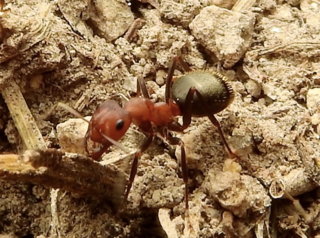  Photo: Tim Shortell |          Wood Ant, Field Ant(Formica spp., Formicidae family)Order: Hymenoptera (Ants, Bees and Wasps) Size: 0.1 - 0.5 in (3 - 13 mm) Distinguishing Features: medium-sized ant that is rusty red to dark brown or black, with a single segment between the thorax and the abdomen Status: native; common Habitat: wooded areas but can be found in and near structures like sidewalks and building foundations Wood ants belong to the Formica genus, and the species are not easy to tell apart. Typically they secrete formic acid, and some can squirt it several feet if alarmed. Nests are often constructed close to small trees and shrubs surrounded by dirt or bits of detritus. The number of ants in a nest can be quite large. Info Photos |
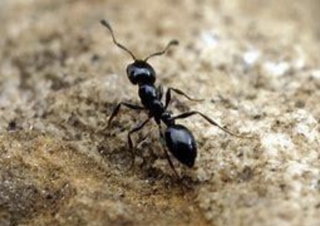  Photo: Isabella Brown |          Little Black Ant, Common Trailing Ant(Monomorium minimum, Formicidae family)Order: Hymenoptera (Ants, Bees and Wasps) Size: 0.1 in (2 mm) Distinguishing Features: tiny and have very little body hair. They are shiny black to dark brown with a single segment between the thorax and abdomen; end of the antennae is club-shaped Status: native; common Habitat: forest edges but often invades buildings Little Black Ants are the most common ants in homes and often are seen carrying food back to their nest. They are scavengers, eating a wide variety of potential foodstuffs. Nests are usually constructed below ground with a small crater at the opening or in rotting wood. Info Photos |
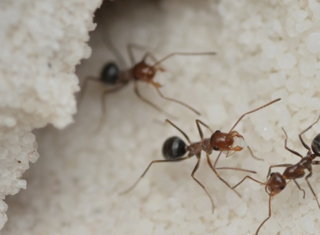  Photo: Robby Deans 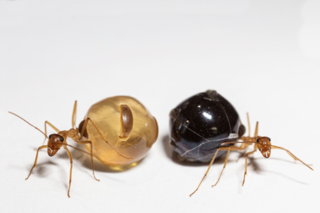  Photo: Repletes by pseudomyrmex 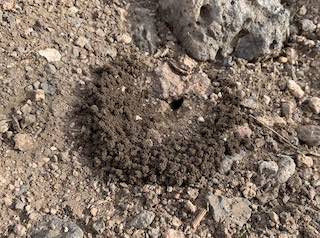  Photo: Founding chamber of a honeypot ant. by Jennifer Macke |          Honeypot Ant, Honey Ant(Myrmecocystus spp., Formicidae family)Order: Hymenoptera (Ants, Bees and Wasps) Size: 0.1 - 0.2 in (3 - 5 mm) Distinguishing Features: medium sized; elongated maxillary palpi; coloration is either reddish with black abdomen, or completely yellow-brown Status: native; locally common Habitat: nests in the soil in arid and semi-arid regions These ants prefer to locate their nests in open areas between plants. The nest entrance is a rounded crater made of small pebbles and soil surrounded by discarded debris. Honeypot ants have a group of specialized workers known as repletes, plerergates, or rotunds. These workers have an abdomen with stiff plates and soft connective tissue that can greatly expand when they gorge themselves on nectar. Repletes hang from the ceiling deep within the nest and serve as living storage containers. Ordinary workers extract food from the repletes through a process known as trophallaxis. This food/water storage system makes them well suited to desert environments. Honeypot ants have foraging territories, and colonies will engage in ritualized battles. If a colony is weak, a stronger colony will raid it, taking its brood and repletes. Info Photos |
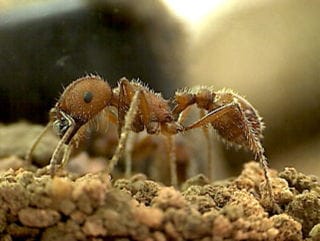  Photo: Beth Cortright 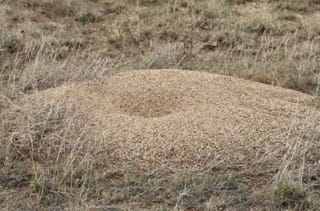  Photo: Melissa |          Harvester Ant(Pogonomyrmex spp., Formicidae family)Order: Hymenoptera (Ants, Bees and Wasps) Size: 0.1 - 0.3 in (2 - 8 mm) Distinguishing Features: largish ant; red or black; blocky head with a beard of coarse hairs and a threadlike waist; distinctive nests Status: native; common Habitat: open, arid areas Harvester ants collect edible seeds and pollen, but will also forage on dead insects and nectar. Colonies are topped with a distinctive conical mound of fine gravel and surrounded by areas devoid of plant life. A colony can contain up to 20,000 workers produced by a single queen. These ants have a painful sting, but are not very aggressive towards humans. Sometimes mistaken for Fire Ants, but not related; Fire Ants are not found in the region around Los Alamos. The most common Harvester Ants in Los Alamos and White Rock are P. occidentalis (Western Harvester Ant), while White Rock also has P. rugosus (Rough Harvester Ant), which is mostly black in color. Info Photos |
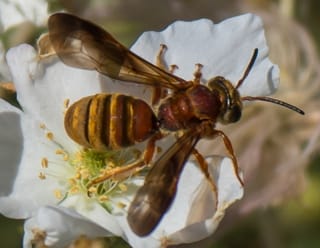  Photo: by Marion L. Stelts 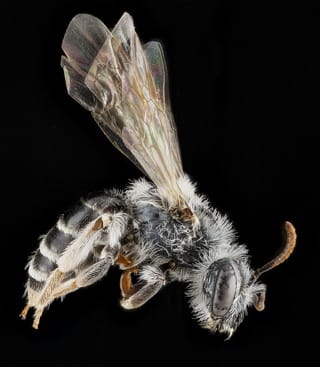  Photo: USGS Bee Inventory and Monitoring Lab |               Mining Bee, Miner Bee, Andrenid Bee(Andrenidae subfamily, Andrenidae family)Order: Hymenoptera (Ants, Bees and Wasps) Size: 0.3 - 0.7 in (8 - 17 mm) Distinguishing Features: moderate-sized bee with scopae or specialized pollen-carrying hairs on their legs; patches of hair between their eyes and at the base of their antennae Status: native; common Habitat: plants in the Rose family in spring and wildflowers later in the year Adult Mining Bees are solitary and emerge from hibernation in spring. After mating, a female will dig a nest with several cells. She lays a single egg into a cell and then provisions it with pollen and nectar before sealing it up and moving on to the next cell. She usually lays about five eggs. Adults are active for only about six to eight weeks. The new generation of adults that emerge will hibernate during winter only to come out the next spring. Little mounds of earth in lawns and soil can be evidence of Mining Bee nests. Mining Bees rarely, if ever, sting and are good pollinators. Info Photos |
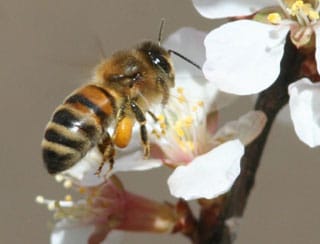  Photo: Selvi Viswanathan |               Honey Bee(Apis mellifera, Apidae family)Order: Hymenoptera (Ants, Bees and Wasps) Size: 0.4 - 0.8 in (10 - 19 mm) Distinguishing Features: overall mostly reddish-brown and black with orange-yellow rings on abdomen; pollen basket on hind legs Status: introduced; common Habitat: workers in areas with high density of flowers; hives in hollow trees or man-made hives maintained by beekeepers The Honey Bee was brought to North America in the 1600s to pollinate crops and produce honey. A colony as large as 60,000 workers will maintain a single queen for up to 2 or 3 years. Honey Bees can sting but are not aggressive; if stung, the stinger should be removed immediately. Due to Colony Collapse Disorder current numbers of bees are abruptly falling leading to concerns about their overall status. Info Photos |
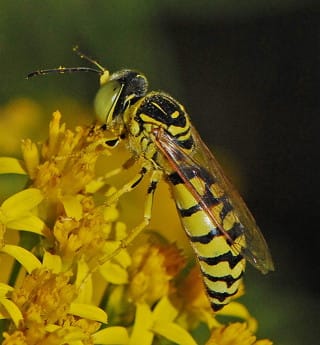  Photo: Jerry Oldenettel |               Sand Wasp(Bembix spp., Crabronidae family)Order: Hymenoptera (Ants, Bees and Wasps) Size: 0.7 - 0.9 in (18 - 23 mm) Distinguishing Features: wasps with a black abdomen and white or yellow curved bands that sometimes meet in the midline; may have greenish eyes Status: native; uncommon Habitat: sandy areas or areas with sparse vegetation and loose soil Females dig nests that typically consist of a short, simple burrow with a single chamber for their eggs. They then stock the nest with captured, paralyzed insects. Adults will continue to provision the nest with food throughout the time that the larvae are developing. Sand wasps can sting but the sting is not as painful as other wasps. Info Photos |
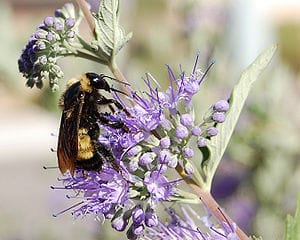  Photo: Skoch3 |               American Bumble Bee(Bombus pensylvanicus, Apidae family)Order: Hymenoptera (Ants, Bees and Wasps) Size: 0.8 - 1 in (19 - 25 mm) Distinguishing Features: yellow thorax and central abdomen with other parts of body being black Status: native; common Habitat: areas with a high density and diversity of flowers The American Bumble Bee can be found throughout North America. In general these bees are not aggressive and will usually only sting when their nests are disturbed. They are generalists and can be seen gathering pollen from a wide variety of flowers. The larger-sized bees seen in the spring are queens that have emerged after overwintering. Info Photos |
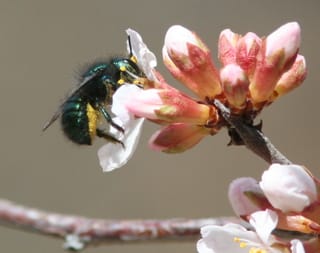  Photo: Selvi Viswanathan 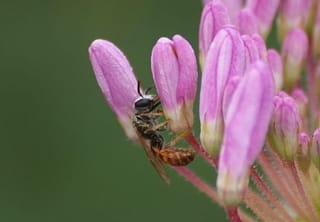  Photo: lostinfog |               Sweat Bee, Halicid Bee(Halictidae family)Order: Hymenoptera (Ants, Bees and Wasps) Size: 0.1 - 0.4 in (3 - 10 mm) Distinguishing Features: generally black or metallic in color; some are brilliant green or brassy yellow Status: native; common Habitat: wide variety of flowers; nests are in the ground or in wood Sweat Bee is the common name for a family of bees that are attracted to salts in human perspiration. There over 200 species of Sweat Bees in the US and it is very difficult to distinguish the different species. Some Sweat Bees are so small that a entire swarm may be missed. Females can sting. Care should be taken to immediately remove the stinger if stung. Info Photos |
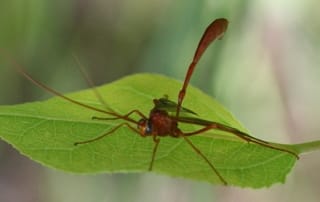  Photo: Selvi Viswanathan 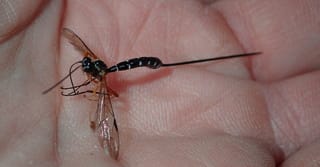  Photo: yetikat |               Ichneumon Wasp(Ichneumonidae family)Order: Hymenoptera (Ants, Bees and Wasps) Size: 0.2 - 5 in (5 - 127 mm) Distinguishing Features: vary greatly in size and color. Have antennae that are longer with more segments than other wasps; long, thin abdomens; females of many species have extremely long ovipositors Status: native; common Habitat: amongst low foliage or grasses Family Ichneumonidae is the largest family of insects, with over 3,000 North American species. They are common insects and occur almost everywhere wandering over the surface of trees and grasses. Ichneumons parasitize a wide range of hosts, mostly other insects. Many ichneumons are internal parasites: the adult female injects her eggs into the body of the host; the larval parasite hatches and develops inside the host; the host typically survives until the parasite pupates. When the female wasp injects her eggs, she also injects certain viruses (polydnavirus) that disrupt the hosts’s immune system. (Yes, insects do have immune systems.) The viruses, which exist only in association with the wasps, enable the wasp to defeat its host. These wasps do not sting. Info Photos |
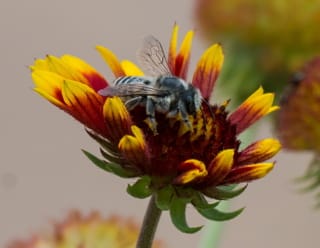  Photo: Marion L. Stelts |               Leaf-cutter Bee, Leafcutting Bee, Mason Bee(Megachilidae family)Order: Hymenoptera (Ants, Bees and Wasps) Size: 0.2 - 0.6 in (5 - 15 mm) Distinguishing Features: medium-sized, stout-bodied, black bees; have hairs on the underside of the abdomen used for carrying pollen and giving it a golden color Status: native; common Habitat: nest in soil, a hole in wood or a hollow plant stem Leaf-cutter Bees are important native pollinators of wildflowers, fruits, vegetables and other crops. Some are even used as commercial pollinators in place of Honey Bees. As their name implies, the bees cut circular pieces of leaves from plants that they use to construct many chambered nests in a protected site. Each chamber contains pollen and a single egg. Most Leaf-cutter Bees overwinter in their nests as newly formed adults. The adults are solitary and will only sting if handled. Info Photos |
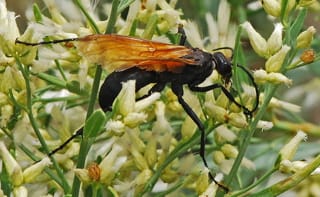  Photo: Jerry Oldennettel |               Tarantula Hawk(Pepsis spp., Pompilidae family)Order: Hymenoptera (Ants, Bees and Wasps) Size: 1.7 - 2 in (43 - 51 mm) Distinguishing Features: large wasps with metallic blue bodies, red or orange wings and long legs ending in claws Status: native; common Habitat: variety of desert habitats often near flowers or on the ground While the adults eat nectar and sometimes rotting fruit, the species is parasitic, i.e., the female paralyzes spiders by stinging them and then laying eggs in the spider's body. The preferred spider is the tarantula, giving the wasp its common name. The Tarantula Hawk's sting is considered to be one of the most painful in the world. Therefore, there are few animals that will eat a Tarantula Hawk, the roadrunner being one of them. The wasp was made the New Mexico state insect in 1989. Info Photos |
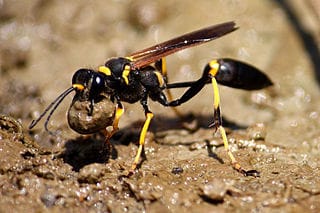  Photo: Hlug1 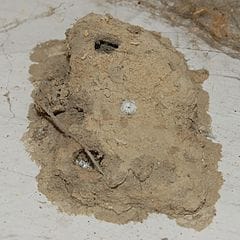  Photo: Eugene Zelenko |               Black and Yellow Mud Dauber(Sceliphron caementarium, Sphecidae family)Order: Hymenoptera (Ants, Bees and Wasps) Size: 1 - 1.1 in (25 - 29 mm) Distinguishing Features: body mostly black with yellow markings on thorax, pedicel (cylindrical segment between thorax and abdomen) and abdominal first segment; legs mostly yellow with wings brown to black Status: native; uncommon Habitat: nests in sheltered areas, under rocks, overhanging cliffs or under eaves of roofs Adults can be seen feeding at flowers. Females create a nest by shaping mud balls into joined tubular cells (bottom photo). Each cell contains numerous paralyzed spiders and one egg. Eventually the hatching larva eats the spiders, grows, spins a cocoon, overwinters as a pupa and ultimately emerges from the nest in the spring as an adult. Stings are painful but the dauber is usually non-aggressive except when defending a nest. Info Photos |
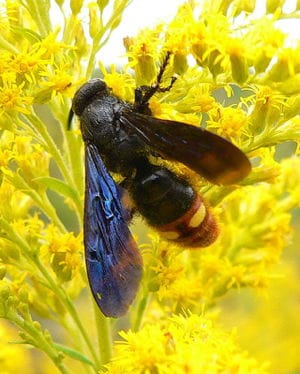  Photo: Greg Hume |               Blue-winged Wasp, Digger Wasp(Scolia dubia, Scoliidae family)Order: Hymenoptera (Ants, Bees and Wasps) Size: 0.8 - 1 in (20 - 25 mm) Distinguishing Features: primarily black and hairy; outer two-thirds of the abdomen is rusty-red with two light-colored dots Status: native; common Habitat: areas with abundant flowers Adults primarily feed on nectar but can take juices from beetle prey. Females will dig in the ground in search of beetle larvae. When found, the female stings the beetle larva to paralyze it, and then burrows further creating a defined cell before laying one egg on the beetle larva's back. The wasp larva feeds on the host, eventually spinning a cocoon within the body of the beetle larva and overwintering as a pupa. Info Photos |
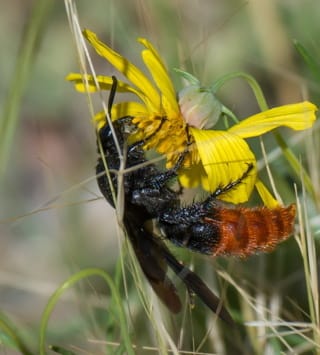  Photo: Marion L. Stelts |               Scoliid Wasp, Flower Wasp(Scoliidae family)Order: Hymenoptera (Ants, Bees and Wasps) Size: 0.8 - 1 in (20 - 25 mm) Distinguishing Features: large, hairy, stout wasps with black antennae and a shiny black head, thorax and fore abdomen; hind abdomen usually colorful, often with patterned spots or bands Status: native; common Habitat: found searching for hosts in fields, meadows and lawns Female Scoliid Wasps dig into the ground to create chambers for their young and to search for ground-dwelling scarab larvae (Scarabaeidae family) to act as hosts. They paralyze the beetle larva by stinging it, move it to one of cells and then lay a single egg on the grub. Thus, since many of the beetles that Scoliid Wasps parasitize are important pests, they are considered to be important biocontrol agents. In addition, adults drink nectar and are minor pollinators for some plants including many wildflowers. Info Photos |
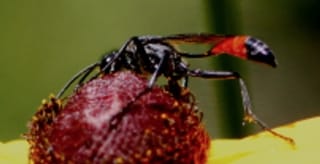  Photo: Selvi Viswanathan   Photo: Emily Hjalmarson |               Thread-waisted Wasps(Sphecidae family)Order: Hymenoptera (Ants, Bees and Wasps) Size: 1 - 1.3 in (25 - 32 mm) Distinguishing Features: long, narrow abdomen giving the impression of a thin waist; body which is hairless can be all black or have some red, yellow or white on it Status: native; uncommon Habitat: most nest in the ground in areas with sparse vegetation; others create nests of mud The Thread-waisted wasps are a diverse group of wasps and includes the sand wasps and mud daubbers. All are predatory with parasitic young. Prey species range from spiders to various insects and even larvae of butterflies. Most Thread-waisted Wasps gather paralyzed prey in some sort of nest in order to provision their young prior to laying eggs. Info Photos |
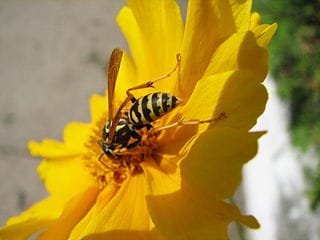  Photo: Audrey |               Yellowjacket(Vespula spp., Vespidae family)Order: Hymenoptera (Ants, Bees and Wasps) Size: 0.4 - 0.5 in (10 - 13 mm) Distinguishing Features: short-waisted and generally black and yellow, though some can be black and white. Yet others may have some red on the abdomen; eyes are encircled in yellow; unlike bees which they are often mistaken for, they are not hairy and do not carry pollen Status: native; common Habitat: nests in protected areas like tree stumps, inside man-mad structures and abandoned rodent burrows Yellowjacket is the common name for a group of predatory wasps with a characteristic, side-to-side flight movement when about to land. They live in colonies with workers (infertile females), queens and male drones. Only the fertilized queen overwinters. Nests are made from wood fiber chewed into a paper-like pulp and can contain thousands of workers. Yellowjackets are important predators of pest insects which they feed to the young larvae. The adults primarily drink fruit juices, nectar, tree sap and a sugary substance that the larvae secrete. Info Photos |
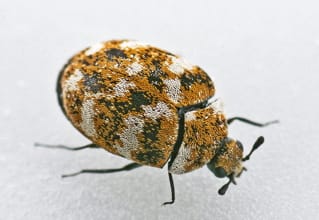  Photo: AJ Cann |                       Carpet Beetle(Anthrenus spp., Dermestidae family)Order: Coleoptera (Beetles) Size: 0.1 - 0.3 in (3 - 8 mm) Distinguishing Features: overall small, round and slightly elongated with brightly colored scales; scale pattern and color varies depending on the species but usually includes brown, white and yellow or red Status: native; common Habitat: gardens and dark areas such as closets, attics and boxes Carpet Beetle larvae eat a variety of household items including carpets, woolens, linens, etc. However, they prefer dead insects and, though they can cause a lot of damage in museums, household damage is usually minimal. Adults prefer the outdoors and typically eat pollen. Info Photos |
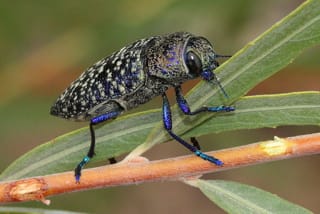  Photo: J. N. Stuart 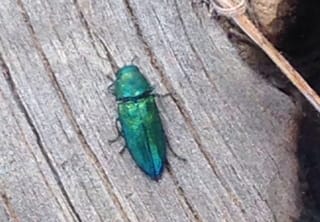  Photo: Arlene Cortez |                       Metallic Wood-boring Beetle, Jewel Beetles(Buprestidae family)Order: Coleoptera (Beetles) Size: 0.2 - 1 in (5 - 25 mm) Distinguishing Features: generally cylindrical to ovoid in shape and diplay a variety of bright, iridescent colors, often in complicated patterns Status: native; uncommon Habitat: attracted to dead or dying trees or branches In some species there are dark-colored covers over the wings. This provides camouflage for the beetle when resting as its bright colors are only seen in flight. The more brightly colored beetles have been used to make jewelry. The larvae (Flatheaded Borers) drill through the wood of various trees and shrubs carving out distinctive, ribbon-shaped tunnels. Info Photos |
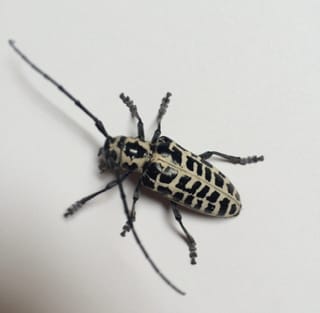  Photo: desertmax 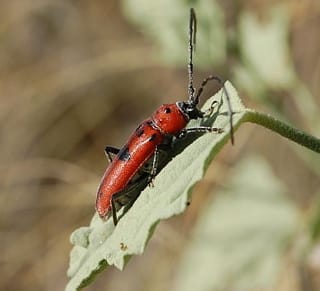  Photo: Skoch3 |                       Long-horn Beetle, Longhorned Beetle(Cerambycidae family)Order: Coleoptera (Beetles) Size: 0.7 - 2.8 in (18 - 71 mm) Distinguishing Features: extremely long antennae which can be as long or longer than the body; body is usually elongated; color and size vary widely Status: native; common Habitat: some species attracted to dead or injured trees; others prefer live vegetation. Adults reproduce and die within a few days to months. Thus, these beetles spend most of their lives as larvae. The larvae typically bore into wood and have enzymes from microflora that aid in the digestion of cellulose. This family includes the wood-borer and root-borer beetles (see separate entry). The larvae can be a pest by doing damage to trees and untreated wood. Info Photos |
  Photo: Michael Schmidt 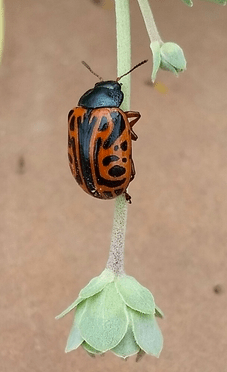  Photo: Thomas Wittaker |                       Leaf Beetle(Chrysomelidae family)Order: Coleoptera (Beetles) Size: 0.1 - 0.7 in (1 - 18 mm) Distinguishing Features: small to medium-sized beetle with a domed, generally ovoid body; depending on the species the body may be brightly colored and/or have a distinctive pattern Status: native; common Habitat: variety of plants including food crops Chrysomelidae is one of the largest families of beetles and is commonly encountered worldwide. Typically there are two generations per year — one in early summer and a second in early fall. Both the adults and larvae eat live plant materials, primarily leaves, but the larvae of some species attack roots and seeds. Most species have a preference for a single plant family. For example, the Globemallow Leaf Beetle (top photo) is found on plants in the mallow family. Whereas, the Three-Lined Leaf Beetle (bottom photo) consumes nightshades like tomatoes and potatoes. Some Leaf Beetles are serious agricultural pests, like the Colorado Potato Beetle, but others are considered beneficial as they can be used to control invasive weeds. Info Photos |
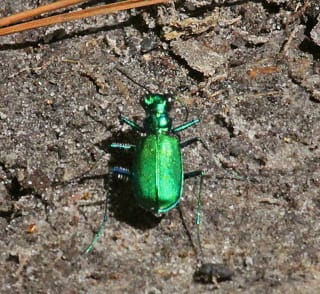  Photo: Jerry Oldenettel 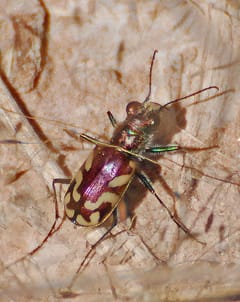  Photo: Jerry Oldenettel |                       Tiger Beetle(Cicindelinae subfamily, Carabidae family)Order: Coleoptera (Beetles) Size: 0.3 - 2.5 in (8 - 64 mm) Distinguishing Features: known for having large bulging eyes, long, slender legs and large curved mandibles; some beetles are brightly colored while others are completely black Status: native; common Habitat: open areas often near water Tiger Beetles are known for their aggressive habits and running speed. They can run down potential mates as well as other arthropod prey. When running they use their antennae as a means of detecting obstacles in their path. Info Photos |
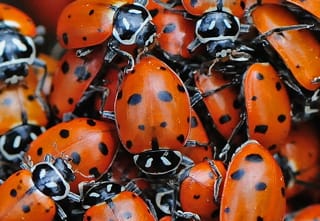  Photo: Jerry Oldenettel |                       Ladybug, Ladybird Beetle, Ladybeetle(Coccinellidae family)Order: Coleoptera (Beetles) Size: 0 - 0.4 in (1 - 10 mm) Distinguishing Features: small oval, dome-shaped beetles; brightly colored, usually red or yellow with spots or stripes, though some species have no markings at all Status: native; common Habitat: areas of dense vegetation near colonies of plant-sucking insects These beetles are are considered to be very useful as most species prey on plant-sucking insects. Many species lay their eggs directly in colonies of aphids or scale insects. Most Ladybugs overwinter by aggregating on the south side of large objects. The adults can secrete a fluid from their joints which makes them have a foul taste, protecting them from predators. The common name “Ladybird”, which is used in most non-US countries and by entomologists, is thought to have originated in the Middle Ages as a dedication to the Virgin Mary. Several species of Ladybirds have been introduced into the US to help control pests but in several cases have become pests themselves. Info Photos |
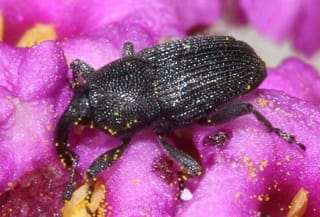  Photo: © Kim Davis and Mike Stangeland 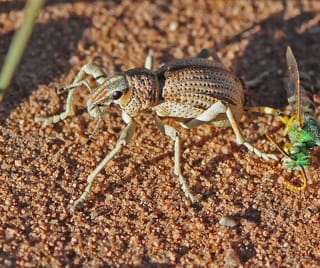  Photo: Jerry Oldenettle |                       Weevil, Snout Beetle(Curculionidae family)Order: Coleoptera (Beetles) Size: 0.4 - 1.5 in (10 - 38 mm) Distinguishing Features: distinctive long snouts and antennae that are bent with a small club at the end Status: native; uncommon Habitat: various types of vegetation and fields of food crops; may be indoors during winter. Weevils make up one of the largest families of insects with greater than 25,000 species in North America. They feed on a wide variety of plants. However, each species may have a limited range of preferred hosts. They are most active at night and can be quite destructive with many species considered serious pests. During the day they can be found hiding under leaves or under debris on the ground. Info Photos |
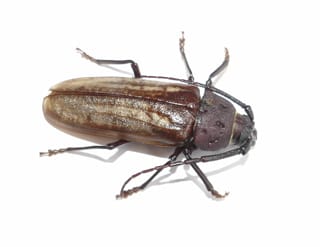  Photo: Ponderous Borer, Ergates sp. by Robert Dryja 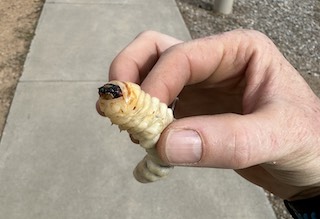  Photo: Beetle larva, exact species unknown. by Corey Quackenbush 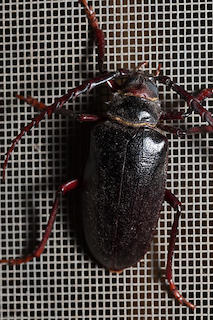  Photo: Borer beetle, Prionus sp. by Jennifer Macke |                       Ponderous Borer, Woodborer; Pine Sawyer(Ergates spp., Prionus spp.)Order: Coleoptera (Beetles) Size: 1.8 - 2.8 in (46 - 71 mm) Distinguishing Features: very large beetles, usually dark brown with lighter brown areas on the wing covers; larvae are creamy white with dark mandibles Status: native; common Habitat: fallen or recently dead pine trees, particularly ponderosa pine The Ponderous Borer and other wood borer beetles are members of the longhorn beetle family, Cerambycidae. Their larvae, which can measure up to three inches in length, have jaws designed for chewing wood. The larvae tunnel from the roots of dying pines up through to the heartwood hastening the decomposition and collapse of dead trees. Adults emerge beginning in midsummer and disperse on nights with a full moon. Photos |
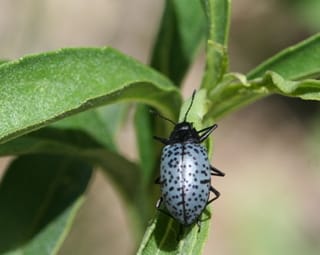  Photo: Selvi Viswanathan |                       Blue Fungus Beetle, Pleasing Fungus Beetle(Gibbifer californicus, Erotylidae family)Order: Coleoptera (Beetles) Size: 0.5 - 0.7 in (13 - 18 mm) Distinguishing Features: main portion of their body is black; elytra or wing covering is bright, purplish blue to a dull grey with black dimples resembling a golf ball; body is elongated and oval Status: native; common Habitat: mid- to high-elevation forests with diseased trees or decaying wood; along streams Adults lay their eggs in the bark of rotting trees such as aspen and ponderosa pine where the fruiting bodies of certain fungi grow. The fungus is used as food by larvae. The larvae develop and eventually pupate while hanging from the underside of the branch or log, sort of like a bat. They eventually emerge in summer as adults. Adults eat fungus as well as pollen and nectar. Info Photos |
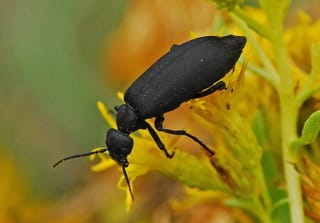  Photo: Jerry Oldenettel 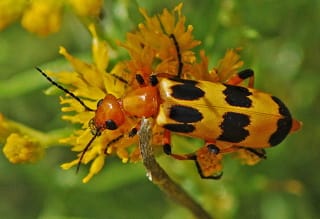  Photo: Jerry Oldenettel |                       Blister Beetle(Meloidae family)Order: Coleoptera (Beetles) Size: 0.4 - 0.7 in (10 - 18 mm) Distinguishing Features: long and slender with many species bicolored; body is narrower than the wing cases; from above, the head appears rectangular and tapers into a small neck Status: native; common Habitat: around flowers, particularly yellow ones The beetles have received their common name from the fact that skin pressed or rubbed against an adult beetle will blister. Unless blistering is severe, treatment beyond first aid is not necessary. Adults feed on leaves and flowers of a variety of plants including some forage crops. Animals, particularly horses, ingesting beetle-contaminated feed can become extremely ill. Info Photos |
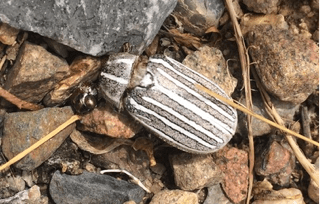  Photo: Laura Hamill 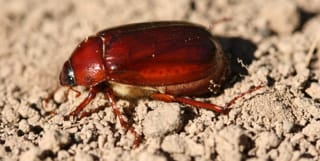  Photo: Steven Katovich |                       June Beetle, May Beetle, June Bug(Melolonthinae subfamily)Order: Coleoptera (Beetles) Size: 0.1 - 0.4 in (3 - 9 mm) Distinguishing Features: heavy-bodied, oval- shaped beetle with distinctive fan-shaped antennae Status: native; common Habitat: near various trees and shrubs at night; attracted to lights June Beetle is the common name for a subgroup of scarab beetles. The Ten-lined June Beetle (top photo) is one of the most common in the area. Most adults are nocturnal and can be seen on warm spring evenings in May and June. These beetles are poor fliers and can actually run into people. If touched, they will make a squeaking noise generated by forcing air out between their wings and back. Larvae mostly live underground and feed on roots. This can weaken or kill plants making them a potential pest. Info Photos |
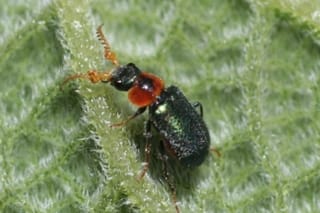  Photo: Whitney Cranshaw |                       Soft-winged Flower Beetle, Flower Beetle, Malachite Beetle(Melyridae family)Order: Coleoptera (Beetles) Size: 0.1 - 0.2 in (3 - 5 mm) Distinguishing Features: most roughly oval in shape and soft-bodied; usually brightly colored, sometimes with a metallic shine; some species the bottom segment of the antenna is enlarged Status: native; common Habitat: larvae in soil; adults in leaf litter or under bark These beetles differ from others in that their bodies are not hard like a shell and are covered with soft hairs. The most common North American species belongs to the genus Collops. They are important predators and prefer soft-bodied plant-eating insects like whiteflies, aphids, mites, and caterpillars. Adults are frequently seen on flowers and among field crops looking for prey. Info Photos |
  Photo: Julie Arington |                       Burying Beetle, Sexton Beetle(Nicrophorus spp., Silphidae family)Order: Coleoptera (Beetles) Size: 0.3 - 0.8 in (8 - 21 mm) Distinguishing Features: primarily a black, ovoid beetle with elytra or wing-coverings that have orange-red bands or patches which can vary in number and shape with the species; several species have long hairs over the surface of the body Status: native; common Habitat: areas with carrion and sometimes rotten fruit This beetle is usually seen at night near rotting materials. Adults will bury a carcass, typically of a mouse, in a small pit and then lay their eggs. Larvae hatch and feed on the carcass until they pupate. Mites are often present on adults (see photo) and may be involved in a symbiotic relationship with the beetles. The mites feed on fly eggs eliminating potential competition for food for the beetle larvae and in exchange are transported to new sources of food. Info Photos |
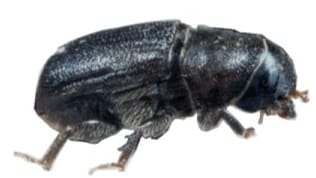  Photo: Forest Service of the US Dept. of Agriculture |                       Bark Beetle(Scolytinae subfamily, Curculionidae family)Order: Coleoptera (Beetles) Size: 0.1 - 0.2 in (3 - 5 mm) Distinguishing Features: small black beetle that is most easily found by observing the red-brown boring dust on tree bark or at the base of a tree Status: native; common Habitat: between the bark and wood of trees and shrubs Adults of most species bore through bark of their host tree and excavate egg galleries between wood and bark. The pattern of engraving that results is typical for each species and different species tend to favor different hosts. To successfully overcome a tree’s defense, mainly heavy flows of pitch, several hundreds or thousands of adult beetles must attack the tree together. If successful, they can kill the tree in two to four weeks. Nearly all mature forests harbor small, relatively harmless infestations of Bark Beetles. Conditions that favor the beetle can, however, quickly cause catastrophic population outbreaks that can last many years. These beetles are the greatest single biological cause of timber loss in the western US, destroying 1 to 5 billion board feet per year. Info Photos |
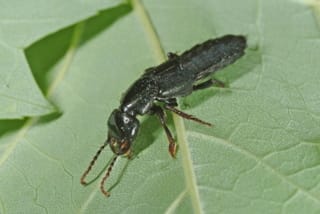  Photo: Joseph Burger |                       Rove Beetle(Staphylinidae family)Order: Coleoptera (Beetles) Size: 0.1 - 0.4 in (2 - 10 mm) Distinguishing Features: most species are generally elongated with parts of their abdomen exposed due to short elytra or wing covers; abdomen is long and flexible Status: native; common Habitat: forest leaf litter and decaying plant material; near fresh water and in soil Members of this beetle family can flex their abdomen upwards and backwards in a defensive posture that resembles a scorpion. However, they do not sting but rather use their mandibles to catch prey. Unfortunately, some Rove Beetles have become a nuisance on New Mexico golf courses due to their burrowing habits in manicured turf. Info Photos |
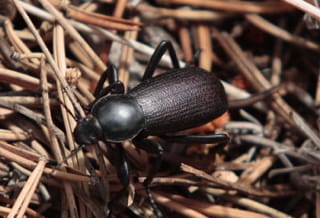  Photo: Josip Loncaric |                       Darkling Beetle, Desert Stink Beetle, Pinacate Beetle(Tenebrionidae family)Order: Coleoptera (Beetles) Size: 0.4 - 1.4 in (10 - 36 mm) Distinguishing Features: will raise their rear end when approached. Their bodies are oval or oblong in shape and either black or dark brown in color; body surface may be smooth or rough; have wings but do not use them Status: native; common Habitat: dry more desert-like areas; active year round and can be seen walking great distances to find food, appearing to wander randomly When alarmed they stand on their heads by bending their front legs down and extending their rear legs. Depending upon the species, they produce a musty secretion that spreads over posterior parts of the body or it can be ejected as a spray. The spray, which is not easily washed off, is not painful unless you get it in your eyes or mouth. The most common species in the area is Eleodes obscurus. Info Photos |
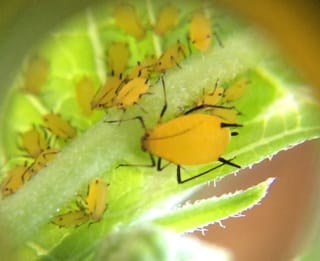  Photo: kliewer |                       Aphid(Aphididae family)Order: Hemiptera (True Bugs, Cicadas, Hoppers, etc.) Size: 0.1 - 0.3 in (3 - 6 mm) Distinguishing Features: soft-bodied insect that may be green but can be other colors including yellow, white, black or even colorless; long, thin jointed legs and sucking mouth parts Status: native; common Habitat: wide variety of plants and trees Aphids are one of the most destructive plant pests. They usually occur in colonies on the underside of leaves where they feed on sap causing the leaves to wilt and yellow. Aphids also produce a sugary liquid called "honeydew" that attracts fungus and other insects. Aphids can reproduce asexually leading to a rapid increase in the population size. Info Photos |
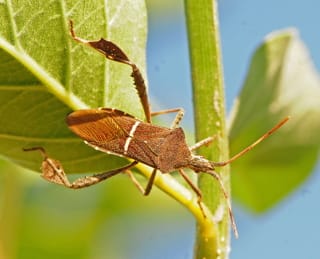  Photo: Jerry Oldenettel |                       Squash Bug, Leaf-footed Bug(Coreidae family)Order: Hemiptera (True Bugs, Cicadas, Hoppers, etc.) Size: 0.2 - 1.6 in (5 - 41 mm) Distinguishing Features: generally ovoid-shaped body, with antennae composed of four segments, numerous veins in the membranes of the fore-wings and visible stink glands; some species have leaf-like expansions on the hind legs Status: native; common Habitat: variety of plants, in particular squash plants Coreidae are considered to be pest bugs as they feed on the sap of plants, primarily garden vegetables in the cucurbits family (squash, pumpkin, zucchini). Eggs are typically cemented beneath foliage. The larvae and smaller bugs often hide under the leaves of these plants. They are often mistaken for stink bugs as they emit a foul odor when crushed as well as when disturbed. Info Photos |
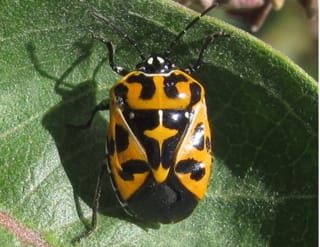  Photo: Chuck Sexton 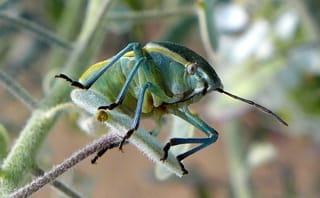  Photo: sea-kangaroo |                       Stink Bug, Shield Bug, Turtle Bug(Pentatomidae family)Order: Hemiptera (True Bugs, Cicadas, Hoppers, etc.) Size: 0.4 - 0.5 in (10 - 13 mm) Distinguishing Features: medium-sized rectangular-shaped insects with overlapping wings on the back resembling a shield; variety of colors and patterns Status: native; common Habitat: most often on various crops Most Stink Bugs are herbivores and are considered to be agricultural pests. They can be seen on a variety of plants where they drink nectar from the flowers or suck the plant juices from the stems and leaves. In contrast, a few species are beneficial as they are predators of other insect pests. They usually capture caterpillars or beetle larvae and suck out their bodily juices. The Stink Bug gets its name from its ability to eject a foul smelling substance from pores in the thorax when disturbed. This is a deterrent for predators. Different species emit different compounds with novel odors. Info Photos |
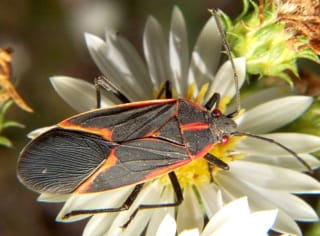  Photo: Bruce Martin |                       Boxelder Bug(Boisea spp., Rhopalidae family)Order: Hemitpera (True Bugs, Cicadas, Hoppers, etc.) Size: 0.4 - 1.6 in (10 - 41 mm) Distinguishing Features: usually has a black or dark brown large oval body with narrow reddish lines on the back and abdomen; has a tiny head Status: native; common Habitat: boxelder, maple and ash trees Boisea is the most well-known genus of North American Boxelder Bugs. The Boxelder Bug is a “true bug” though it is often mistaken for a beetle. It feeds primarily on seeds and is usually harmless. However, they can become a nuisance in fall when their numbers increase dramatically and they try to find protected places to overwinter such as in homes. Info Photos |
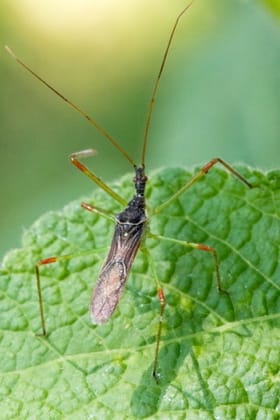  Photo: Graham Mark |                       Assassin Bug(Reduviidae family)Order: Hemitpera (True Bugs, Cicadas, Hoppers, etc.) Size: 0.2 - 1.6 in (5 - 41 mm) Distinguishing Features: elongated head with narrowed neck and prominent mouth parts; long legs and wings Status: native; uncommon Habitat: species that feed on insects can be found near several different kinds of plants; those that feed on blood may invade burrows, nests, dens and even homes Most Assassin Bugs prey on insects by injecting a lethal saliva that liquefies the insides of the prey so it can then be sucked out. A few species, often known as Kissing Bugs, live by biting vertebrates, including humans, and sucking their blood. If harassed, even Assassin Bugs that feed on insects can deliver a painful bite by injecting venom or digestive juices. Assassin Bugs use a structure of ridges called a stridulatory organ to produce sound to discourage predators. Info Photos |
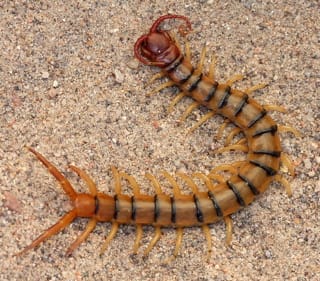  Photo: J.N. Stuart 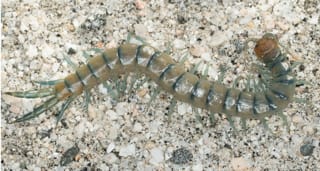  Photo: Jesse Rorabaugh 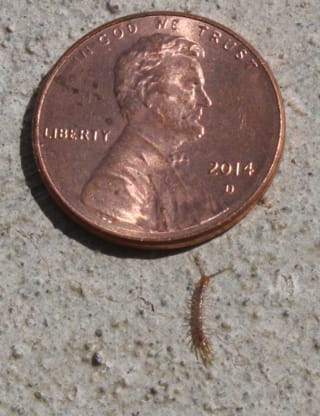  Photo: Akkana Peck |     Desert Centipede, Common Desert Centipede, Tiger Centipede, Banded Desert Centipede(Scolopendra polymorpha, Scolopendridae family)Order: Scolopendromorpha (Tropical Centipedes) Size: 4 - 7 in (102 - 178 mm) Distinguishing Features: cylindrical body with one pair of legs per body segment; overall color variable from brown to red to orange to blue; one dark lateral stripe on each segment Status: native; common Habitat: dry areas of forest and desert where it lives under rocks or in rotting logs During the daytime the Desert Centipede hides from the sun underground or under rocks. It comes out at night to hunt insects, lizards, frogs and small rodents. Centipedes use the pincher-like appendages in front of their legs to inject venom into their prey. Female centipedes care for their eggs by curling around them, potentially to protect them from mold and bacteria. The females will continue to care for the young for a few days more after they have hatched (young centipede, bottom photo). The Desert Centipede is not easily provoked. However, its bite or more accurately a pinch, while not dangerous, is very painful — the larger the centipede the more painful. Info Photos |
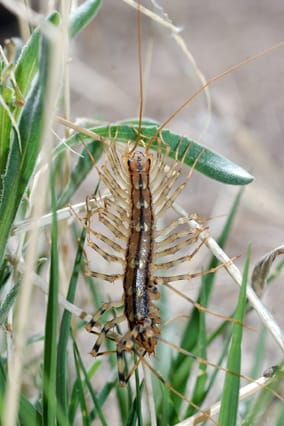  Photo: Sally King |     House Centipede(Scutigera coleoptrata, Scutigeridae family)Order: Scutigeromorpha (House Centipedes) Size: 1 - 1.4 in (25 - 36 mm) Distinguishing Features: yellowish-grey body with a pair of delicate legs per segment and three dark stripes running down its length; long and multi-segmented antennae Status: introduced; common Habitat: most live outdoors in cool, damp places under rocks or piles of wood or compost; can live their entire life within a building House Centipedes are indigenous to the Mediterranean region. However, they have spread throughout most of Europe, Asia and the Americas. They primarily hunt at night for spiders and insects (termites, cockroaches, ants, silverfish, etc.) relying heavily on their antennae which are sensitive to both smells and touch. House centipedes jump on or “lasso” their prey with their legs and can hold multiple small insects at the same time. When discovered in a house, their appearance and incredible speed usually startles the observer. Bites are not common and not considered to be dangerous as the centipede’s pincers are not strong enough to easily penetrate human skin. Info Photos |
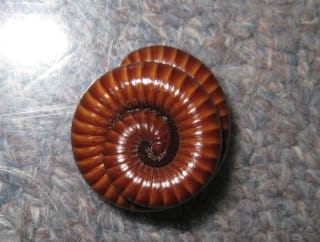  Photo: Jennifer Macke 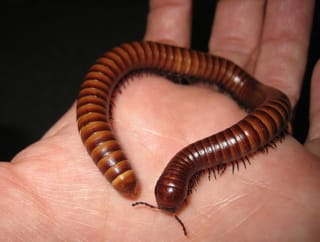  Photo: Jennifer Macke |     Desert Millipede(Orthoporus ornatus, Spirostreptidae family)Order: Spirostreptida (Millipedes) Size: up to 6 in (152 mm) Distinguishing Features: long, cylindrical body that is brown or black with two pairs of legs per hard body segment; number of segments vary as new segments are added each time they shed Status: native; common Habitat: primarily lives underground in burrows that they dig themselves Desert Millipedes are primarily nocturnal but will come out above ground after a rain. Millipedes play an important role in the ecosystem by feeding on decaying organic materials. This is particularly important in this area as things are very dry and dead plants take a long time to completely decompose. It is a mellow, slow-moving creature. However, if disturbed, it will curl up into a ball and may release a smelly, bad-tasting, irritating substance from an area just above its legs. Info Photos |
  Photo: Heidi Hopkins |     Sand Cockroach, Desert Cockroach(Arenivaga spp., Polyphagidae family)Order: Blattodea (Cockroaches and Termites) Size: 0.5 - 0.9 in (13 - 23 mm) Distinguishing Features: females are rounded, dark brown without wings but with short legs and antennae; males have tan, flattened bodies with long wings and antennae Status: native; uncommon Habitat: areas with sandy soil Unlike other more common cockroach species like the German Cockroach, Sand Cockroaches are native to the US and are not pests. They are not known to live indoors and are more typically found in the southern part of the state. Arenivaga species are sexually dimorphic. Males (left-side of photo) are short-lived and primarily stay above ground. Females (right-side of photo) live underground and sometime reside in small mammal burrows. They feed on fungi and plant detritus and seeds. They surface to attract males at night and once they have mated will rebury themselves. Info Photos |
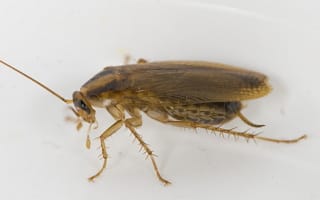  Photo: D. Sikes 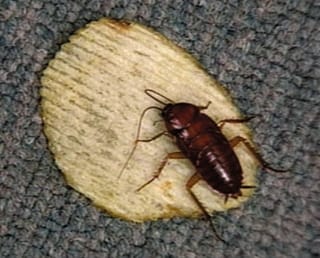  Photo: Janet Hurley |     Cockroach(Ectobiidae family, Blattellidae family)Order: Blattodea (Cockroaches and Termites) Size: 0.4 - 1.2 in (10 - 30 mm) Distinguishing Features: flattened, oval-shaped, brown to black bodies with long, spiny legs; head is small and covered by a plate-like structure; adults of some species have wings but usually only use them to glide Status: introduced; common Habitat: warm, dark, moist areas Cockroaches are a widely distributed group of insects that have adjusted to living with humans and are pests in most areas. The German Cockroach (top photo) which originated in Southeast Asia is the most common cockroach species in US houses, apartments, and other buildings. It feeds on all types of food and garbage and may even eat non-food stuffs like soap and glue. Other common introduced pests are the Oriental Cockroach (bottom photo) and the American Cockroach, which, despite its common name, was introduced from Africa. Cockroach eggs are encased in oval-shaped cases that are typically dark brown in color. Young cockroaches appear similar to adults but are pale in color and do not have wings. Info Photos |
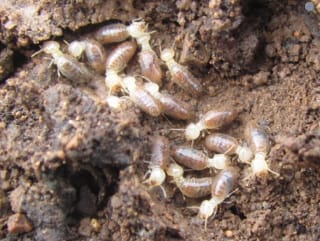  Photo: Chuck Sexton 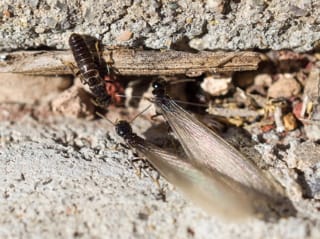  Photo: Jennifer Macke |     Termite(Epifamily Termitoidae)Order: Blattodea (Cockroaches and Termites) Size: 0.3 - 0.4 in (6 - 10 mm) Distinguishing Features: tube-shaped insect without a pinched waist like an ant; also has straight rather than bent antennae. Swarming adults have four wings of equal size Status: native; common Habitat: colonies consisting of a series of tunnels either underground or in wood Termites are eusocial in that a single female or caste produces the offspring and non-reproductive individuals cooperate in caring for the young. Unlike ants, bees and wasps, termites do not have haplodiploid genetics, i. e., unfertilized eggs do not develop. There are sterile males and females that act as “workers” (top photo) which are primarily white in color or “soldiers” with red specialized heads designed for defense. These termites do not usually come above ground. However, fertile "kings" and "queens" will leave the nest to establish a new colony once the current colony reaches a certain size (bottom photo). Termites generally nest in soil. Their nests are made up of tunnels carved out of the dirt with bits of chewed wood and excrement. Termites derive their nutrition from wood products, leaves, grasses and other material with cellulose. The cellulose is broken down by one-cell organisms that live in the gut. Info Photos |
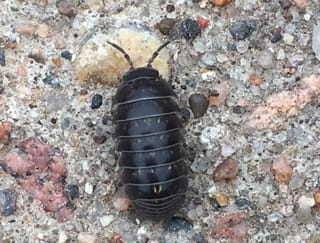  Photo: mdwerne 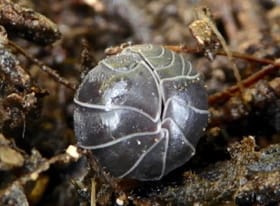  Photo: dlbowls |    Pillbug, Woodlouse(Armadillidium spp., Armadillidiidae family)Order: Isopoda (Woodlice) Size: 0.3 - 0.5 in (6 - 13 mm) Distinguishing Features: dark gray oval body made up of several segments (convex above and concave below); two pairs of antennae, only one of which is visible; no short, pointy “tails” at the rear end Status: introduced; common Habitat: found in damp places like under mulch and logs or in basements and garages Pillbugs, members of the woodlouse family, are best known for their ability to curl up into a ball when disturbed. They are native to Europe, in particular the Mediterranean Basin, but have taken up residence in other areas including North America. Pillbugs are one of the few crustaceans that live their entire life on land. However, since they are unable to retain water they must live in damp places. They are scavengers, eating decaying plants and debris. As such they play an important role in the soil ecology. Info Photos |
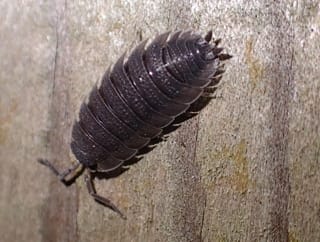  Photo: J. Vaughn |    Sowbug, Woodlouse(Porcellio spp., Porcellionidae family)Order: Isopoda (Woodlice) Size: 0.3 - 0.5 in (6 - 13 mm) Distinguishing Features: dark gray oval body made up of several segments (convex above and concave below); two pairs of antennae, only one of which is visible; two short, pointy “tails” at the rear end Status: introduced; common Habitat: found in damp places like under mulch and logs or in basements and garages Sowbugs are members of the woodlouse family. They are native to Central and Western Europe but have colonized parts of Africa and North America. Sowbugs, despite being a crustacean, live their entire life on land but must spend most of their time in a damp area. They eat organic debris and decaying plants. They can be a nuisance but do not bite, sting or transmit diseases. Also they cannot roll up into a ball like Pillbugs. Info Photos |
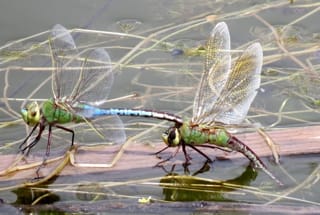  Photo: Blaire Bradley 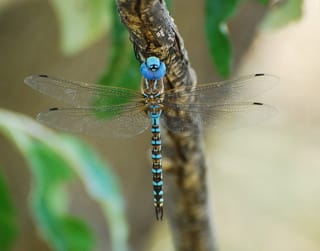  Photo: Jerry Oldenettel |      Dragonfly (Darner)(Aeshnidae family)Order: Odonata (Dragonflies and Damselflies) Size: 2.2 - 3.4 in (56 - 86 mm) Distinguishing Features: huge head with eyes that touch, clear wings and a long, thin abdomen that ends in a small fork which resembles a darning needle; color varies from bright hues to browns Status: native; common Habitat: patrols near waterways and over fields Darners are large, fast flying dragonflies. They usually fly in straight lines and are rarely seen perching. Some Darners will swarm like bees when hunting and the food is plentiful. The Green Darner (top photo) is common in the area. Info Photos |
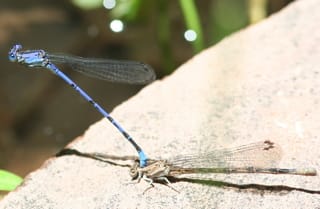  Photo: Selvi Viswanathan 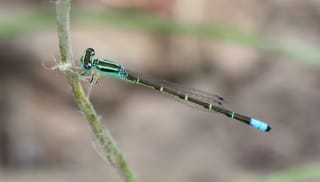  Photo: J. N. Stuart 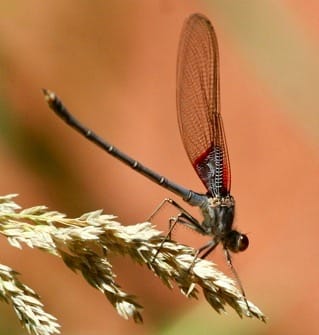  Photo: Selvi Viswanathan |      Damselfly(Coenagrionidae family)Order: Odonata (Dragonflies and Damselflies) Size: 1.4 - 3.5 in (36 - 89 mm) Distinguishing Features: similar to a dragonfly but with a longer and thinner abdomen, often with a black pattern; eyes are smaller and more widely separated; wings are colorless and clear and held together when at rest; in many species the males are brightly colored while the females are more drab Status: native; common Habitat: around live and dead partially submerged vegetation The Coenagrionidae family is one of several damselfly families. Members of this family are known as “Pond Damselflies”. The Familiar Bluet Damselfly (top photo) is one of the most common in the family. Damselflies hover among grasses and low vegetation using their legs to pick prey (soft-bodied insects like gnats and mosquitoes) off stems and leaves. They predominately use their vision to find prey but may also make use of their sense of smell. Artificial flies that mimic damselfly nymphs are sometimes used in fly-fishing. Info Photos |
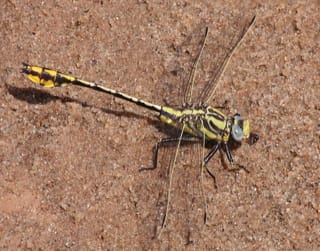  Photo: J. N. Stuart 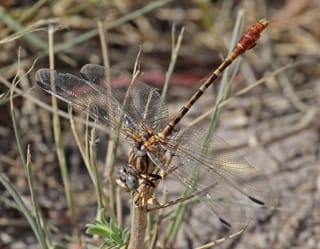  Photo: Jerry Oldenettel 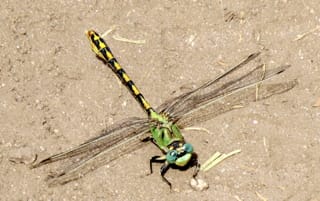  Photo: Blaire Bradley |      Dragonfly (Clubtail)(Gomphidae family)Order: Odonata (Dragonflies and Damselflies) Size: 1.6 - 2.8 in (41 - 71 mm) Distinguishing Features: noticeably thin/pinched abdomen with widened “club” at tip; clear wings, usually black and yellow body, smallish head with separated eyes Status: native; common Habitat: perch on rocks mid-stream Clubtail dragonflies spend much of their time at rest, often perching on the ground or on leaves with the abdomen sloping up and its tip curling down a little. They will rapidly dart forth from their perch to prey on flying insects. The Plains Clubtail (top photo) can be commonly found in the area. Info Photos |
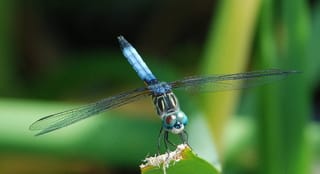  Photo: Jerry Oldenettel 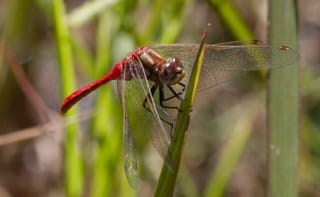  Photo: Chuck Hathcock, LANL |      Dragonfly (Skimmer)(Libellulidae family)Order: Odonata (Dragonflies and Damselflies) Size: 0.9 - 2.2 in (23 - 56 mm) Distinguishing Features: shorter and thicker abdomen than other dragonfly families, the end of which is fairly pointed; eyes are large and touching; males are brightly colored, some with patterned wings; females have similar markings but are much duller in color Status: native; common Habitat: still, shallow water with submerged vegetation in sunny areas Most dragonflies that people see are Skimmers. One of the most common in the area is the Blue Dasher (top photo). They can be seen perching on vegetation along the edge of a pond or marshy area, only to fly out to capture their prey (primarily midges and mosquitos) and then return to their original perch. Their flight is often more fluttery and bouncy than that of dragonflies from other families. Most males are highly territorial and spend much of their adult lives chasing and battling with each other. Info Photos |
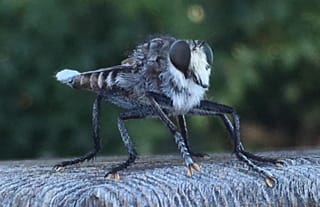  Photo: Leigh Cash |            Robber Fly(Asilidae family)Order: Diptera (Flies) Size: 0.4 - 0.6 in (9 - 15 mm) Distinguishing Features: characteristic divot on top of the head located between very prominent compound eyes; most species have an elongated body with a tapered abdomen Status: native; uncommon Habitat: adults in arid, sunny areas; larvae in soil and decaying wood Robber flies have voracious appetites and are opportunistic predators, feeding on whatever prey is available in the local area. They are one of the few insects fast enough to catch Tiger Beetles. They are considered to be beneficial to gardens as they eat a variety of insects. Robber Flies are generally solitary and can bite if handled. Info Photos |
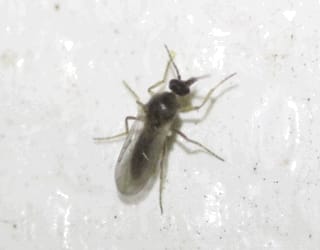  Photo: Tony Palmer |            Biting Midge, No-see-um(Ceratopogonidae family)Order: Diptera (Flies) Size: 0 - 0.1 in (1 - 2 mm) Distinguishing Features: very small dark fly with long, multi-segmented antennae; the wings are broad and mottled Status: native; common Habitat: in areas with water, decaying vegetation or manure Both sexes feed on nectar. However, females must feed on blood in order for their fertilized eggs to mature properly. Swarms of females bite at dusk. The bite is felt as a sharp prick and can leave an itching lump for several hours-to-days due to a reaction to the insect’s saliva. Eggs are laid in a variety of damp locations and develop into adults in about three weeks. While Biting Midges are capable of transmitting diseases to livestock in the US, no cases of human infection have been reported. Info Photos |
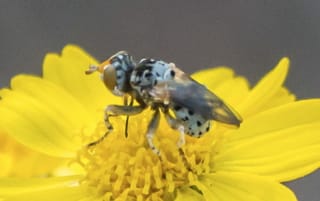  Photo: Marion L. Stelts   Photo: Ken-ichi Ueda |            Tiger Fly, Hunter Fly(Coenosia spp., Muscidae family)Order: Diptera (Flies) Size: 0.2 - 0.3 in (6 - 7 mm) Distinguishing Features: small fly that looks very much like a common house fly but often with distinctive patterns of stripes or spots Status: native; common Habitat: orchards and greenhouses as well as gardens Coenosia is a very large genus of predatory flies in the Muscidae family (House Flies and Kin). Tiger fly larvae live in loose soil where they prey on soft-bodied creatures such as maggots and other larvae as well as earthworms. Adults sit on leaves and other surfaces in grassy habitats waiting for something to fly by. Then they fly out in pursuit, catch the prey, and return to the original spot. Info Photos |
  Photo: Christophe Quintin |            Mosquito(Culicidae family)Order: Diptera (Flies) Size: 0.1 - 0.3 in (3 - 6 mm) Distinguishing Features: thin legs and a slender body with seven abdominal segments; proboscis or tube-like mouthparts are quite prominent Status: native; common Habitat: near standing water, though some species will lay eggs in slow-moving streams Mosquitos typically feed on nectar and other sources of sugar. However, females must feed on blood from any of a variety of sources including amphibians, birds, reptiles, and mammals in order for their eggs to develop. Adult mosquitoes usually mate soon after emerging from the pupal stage. After having a blood meal, the female will rest for a few days while the blood is digested and eggs develop before laying them on or above water. Females typically live only a week or two but may repeat the mating and egg laying cycle several times. There are several genera of mosquito found in New Mexico, some of which are potential carriers of human diseases. For example, West Nile Virus has been reported in Los Alamos County. Info Photos |
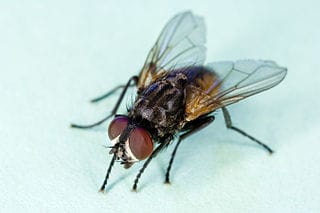  Photo: US Dept Agriculture |            House Fly, Housefly(Musca domestica, Muscidae family)Order: Diptera (Flies) Size: 0.3 - 0.5 in (8 - 13 mm) Distinguishing Features: reddish eyes with stripe between, overlapping mouth parts and four black stripes along the back of the thorax; distance between the eyes of a female is twice as wide as that of a male Status: introduced; common Habitat: areas with garbage and feces The Housefly is the most common domestic fly. It originated in Eurasia but is now distributed all over the world. The female House Fly mates once and then stores sperm for later use. Eggs are laid in garbage, carrion or feces which provide an adequate food supply for the growing maggots. Adults usually only live a few weeks but may hibernate during winter. They live off of a variety of liquid and semi-liquid substances which they generate by using their saliva on solid food stuffs. House Flies can pick up a large number of pathogens from garbage and sewage and then transmit them to human and animal food via contaminated saliva or body parts or through their feces deposited on food. Info Photos |
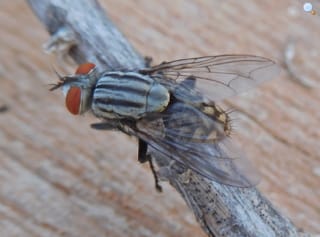  Photo: Ellen Hildebrandt |            Flesh Fly(Sarcophagidae family)Order: Diptera (Flies) Size: 0.4 - 0.5 in (10 - 13 mm) Distinguishing Features: black and gray stripes on the thorax and checkered, bristled abdomen; eyes are prominent and red Status: native; uncommon Habitat: around carrion, dung and on animals with open wounds The majority of Flesh Fly species are scavengers. They attack small carrion such as dead insects rather than larger vertebrates. They are also known to eat decaying vegetable matter and excrement so can be found around compost heaps and latrines. Flesh Flies can carry diseases but are thought to pose little threat to humans or livestock. In fact, some species are considered to be beneficial as they prey on eggs and larvae of more harmful insects. Flesh Flies are ovoviviparous in that they deposit hatched or hatching maggots instead of eggs. The maggots then develop into adults in less than three weeks. Info Photos |
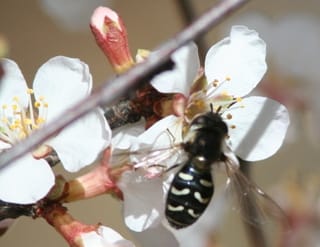  Photo: Selvi Viswanathan |            Hoverfly, Flower Fly, Syrphid Fly(Syrphidae family)Order: Diptera (Flies) Size: 0.4 - 0.6 in (10 - 15 mm) Distinguishing Features: slim, elongated body with large reddish eyes, dark thorax, black and yellow striped abdomen and clear wings Status: native; uncommon Habitat: variety of different flowers Hoverflies are important pollinators of a large variety of flowering plants. They are second only in importance to wild bees. As their name implies adult flies are most often seen hovering over or gathering nectar and pollen from flowers. In contrast, the larvae eat a variety of foods ranging from decaying plant and animal matter to plant-sucking insects such as aphids. Despite mimicking the appearance of a wasp, Hoverflies do not sting or bite. Rather the resemblance is used as camouflage against predators. Info Photos |
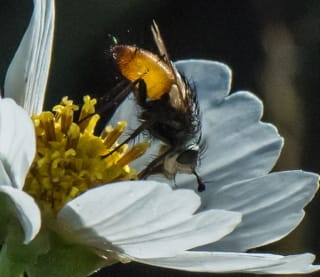  Photo: Marion L. Stelts 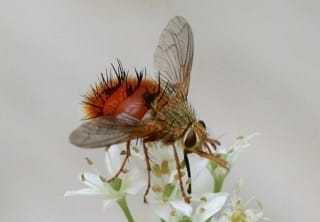  Photo: Selvi Viswanathan |            Tachinid Fly, Tachinid(Tachinidae family)Order: Diptera (Flies) Size: 0.1 - 0.7 in (2 - 18 mm) Distinguishing Features: variable in appearance with some brightly colored and others rather dull; antennae are aristate, i.e., pouch-like with a lateral bristle; most species are bristly and have large flaps in front of the wings (calypters) Status: native; common Habitat: sunny hilltops Tachinid flies lay their eggs near or in caterpillars and larvae of other insects. They tend to not restrict themselves to a single host species and usually lay only one egg per host. Larvae from most species are parasitoid, i.e., developing inside the host and ultimately killing it. However, a few do not kill the host but rather just parasitize it. Adults are not parasitic. They either do not feed at all or get only enough energy from flowers or decaying matter to sustain themselves during mating. In this way they help to pollinate plants, particularly at higher elevations where many bees cannot survive. In some areas, Tachinids are used as a biological control against various insect pests. Info Photos |
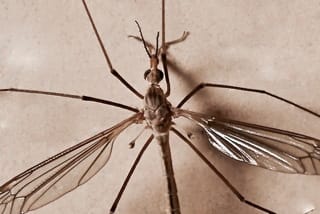  Photo: Graham Mark |            Crane Fly, Gallinnipper(Tipulidae family)Order: Diptera (Flies) Size: 0.4 - 1.3 in (10 - 33 mm) Distinguishing Features: resembles an oversized mosquito with a slender body and thin legs that can easily come off the body; wingspan can be as much as 2.5 in (6.5 cm); "beak" or rostrum is very long Status: native; common Habitat: prefers damp places; adults may find a way indoors Despite rumors to the contrary, the Crane Fly is neither related to a mosquito nor a predator of mosquitos. They neither bite nor sting. The adults only live a few days and, in general, do not eat anything. Crane Flies spend most of their time as larvae living under water. The adults only emerge to mate. Info Photos |
  Photo: Mathew Bowser |            Flea(Pulicidae family)Order: Siphonaptera (Fleas) Size: 0.1 - 0.1 in (2 - 3 mm) Distinguishing Features: small wingless insects with skin-piercing mouthparts; hind legs are long and adapted for jumping Status: native; uncommon Habitat: associated with mammal and bird habitats Adult Fleas live off of the blood of mammals and birds. Females can attach themselves to a site and feed for several days causing the site to become swollen and ulcerated. The females then lay their eggs in the ulcer. Once the larvae hatch they drop to the ground and live on organic debris. The climate in New Mexico, in general, is too dry for many types of fleas including the typical dog and cat fleas. However, one common flea in the area is the Sticktight Flea (Echidnophaga gallinacea) which can attach tightly to a pet, particularly on the face. This flea does not carry plague but many of the other fleas in New Mexico do. The plague-carrying fleas are mostly associated with squirrels and other rodents like prairie dogs. Info Photos |
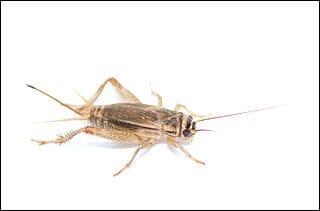  Photo: Brian Gratwicke |         House Cricket(Acheta domestica, Gryllidae family)Order: Orthoptera (Grasshoppers, Katydids and Crickets) Size: 0.6 - 0.9 in (16 - 22 mm) Distinguishing Features: stout, cylindrical yellowish-brown body; at rest the hind wings project out over the abdomen. Status: introduced; common Habitat: areas with potential scrap vegetation under rocks and in crawl spaces Often a nuisance because of its constant chirping at night. Present year round. They prefer to eat soft plant matter, other insects, and carrion. This is the variety of cricket that is used to feed many of the exhibit animals at PEEC. Info Photos |
  Photo: erobers   Photo: Greg Lasley |         Grasshopper, Short-horned Grasshopper(Acrididae family)Order: Orthoptera (Grasshoppers, Katydids and Crickets) Size: 1 - 4.3 in (25 - 109 mm) Distinguishing Features: medium to large insects with impressive mouthparts for chewing; they have short antennae and long hind legs for jumping; two pairs of wings: one narrow and tough and the other wide and flexible Status: native; common Habitat: fields of grasses and cereal crops as well as in open areas Grasshoppers in the family Acrididae are known as Short-horned Grasshoppers to distinguish them from Long-horned Grasshoppers or Katydids that have much longer antennae. Most Short-horned Grasshoppers like the Pallid-winged Grasshopper (top photo) are solitary. However, under certain environmental conditions and high population densities, some species can change behavior and color. Swarming grasshoppers are known as locusts. The Carolina Grasshopper (bottom photo) is one of the common species in the area that will swarm. Grasshoppers are typically ground-dwelling insects with the ability to leap long distances to help them escape from predators. They are polyphagous, feeding on a variety of different plant sources, though they prefer grasses including cereal crops. Males can make a churring sound by rubbing their hing leg against the forewing to attract mates. Females usually lay their eggs on bare soil or near roots. Info Photos |
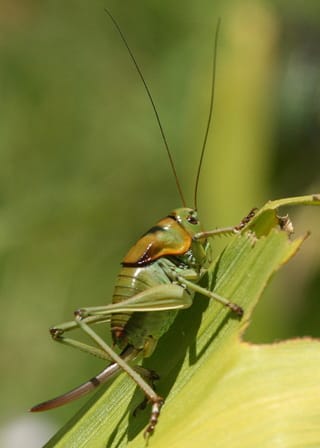  Photo: J. N. Stuart |         Mormon Cricket(Anabrus simplex, Tettigoniidae family)Order: Orthoptera (Grasshoppers, Katydids and Crickets) Size: 2.5 - 3 in (64 - 76 mm) Distinguishing Features: lot of variability in the species with overall color being black, brown or green; abdomen may be striped; vestigial wing coverings may have color markings; females have a long ovipositor that resembles a stinger but is not; both sexes display long antennae Status: native; locally common Habitat: found up to 11,000 ft (3,400 m) in grassy areas The Mormon Cricket is not actually a cricket but a shield back katydid and is flightless. Adults lay eggs throughout the summer which do not hatch until the next spring. Mormon Crickets primarily eat grasses and shrubs but will eat food crops as well. Periodic population explosions lead to roving bands of these insects with destruction of range and croplands. The "cricket" received its common name from Mormon settlers who encountered swarms of them in Utah. According to traditional accounts, gulls swooped in, eating the insects thus saving their crops. Info Photos |
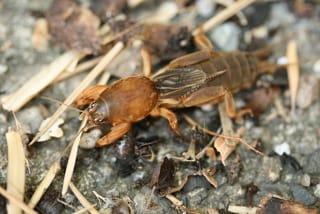  Photo: dogtooth77 |         Mole Cricket(Gryllotalpidae family)Order: Orthoptera (Grasshoppers, Katydids and Crickets) Size: 0.8 - 1.4 in (20 - 36 mm) Distinguishing Features: cylindrical bodies covered in fine dense hairs with broad, toothed forelimbs; eyes are small and beady Status: native; uncommon Habitat: live almost entirely underground Their forelimbs are particularly adapted for digging tunnels for different purposes. The hind legs, although more cricket-like, are used for pushing soil rather than leaping. Their main tunnels are used for feeding and escape from predators. Other tunnels are used for mating and raising young. Most Mole Crickets can fly but not well. Males have a very loud song for attracting mates. Info Photos |
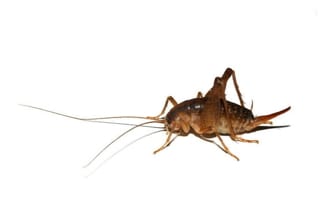  Photo: Phil Myers |         Camel Cricket, Camelback Cricket(Rhaphidophoridae family)Order: Orthoptera (Grasshoppers, Katydids and Crickets) Size: 0.4 - 1.7 in (10 - 43 mm) Distinguishing Features: typically black or brown with a humpbacked appearance; very large, thick hind legs and long, slender antennae Status: native; common Habitat: dark, damp places under leaves, rocks and loose tree bark These crickets can be a nuisance in buildings and homes in areas that provide dark, moist conditions such as a basements. They rely heavily on their sense of touch, which is limited by reach, hence the long antennae. The Camel Cricket is not a “true cricket” as it lacks wings. Also males do not make a chirping noise. Info Photos |
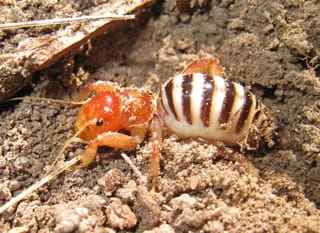  Photo: Jennifer Macke |         Jerusalem Cricket, Nino del la Terra(Stenopelmatus spp., Stenopelmatidae family)Order: Orthoptera (Grasshoppers, Katydids and Crickets) Size: 1.8 - 2 in (46 - 51 mm) Distinguishing Features: very large head with beady black eyes and long striped body Status: native; uncommon Habitat: among flowers; often hide under rocks or logs and even in dark places indoors during the hot weather Jerusalem Crickets are flightless, nocturnal insects that primarily eat dead organic matter and other insects. They are nonvenomous but will bite and produce a foul smell. They are not "true crickets" but similar to them in that Jerusalem Crickets have drumming-like song used during mating. Info Photos |
  Photo: Cullen Hanks 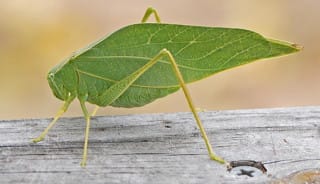  Photo: Jerry Oldenettel |         Katydid, Long-horned Grasshopper(Tettigoniidae family)Order: Orthoptera (Grasshoppers, Katydids and Crickets) Size: 0.5 - 4.4 in (13 - 112 mm) Distinguishing Features: typically green or brown with long back legs for jumping; may have a leaf-shaped body Status: native; uncommon Habitat: associated with deciduous trees and shrubs Many Katydids (top photo) look much more like a typical grasshopper but with longer antennae giving the family the name of Long-horned Grasshoppers. However, some Katydids like the Angle-winged Katydid (bottom photo) have a more leaf-like shape that serves them as camouflage when resting in trees. The adults tend to be more active at night when they make chirping noises with their wings to attract mates. Females glue their eggs in overlapping patterns on the edges of leaves and twigs. The eggs themselves are flat and often missed. Adults emerge in mid-summer and are present until mid-fall. Both larvae and adults mostly eat leaves and grasses. Severe damage to plants by katydids is rare. Info Photos |
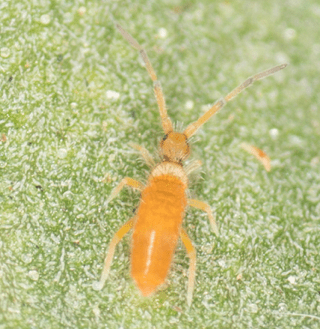  Photo: Jesse Rorabaugh 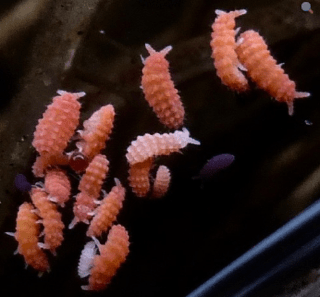  Photo: dlbowls 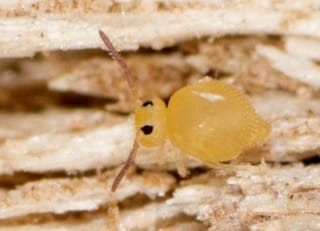  Photo: Jesse Rorabaugh |        Springtail(Entomobryomorpha, Poduromorpha and Symphypleona families)Order: Collembola (Springtails) Size: up to 0.2 in (5 mm) Distinguishing Features: elongated, oval or globular body depending on the family; abdominal appendage folded under the body; wingless but with eye clusters (six photosensitive eyes and two eyes sensitive to polarized light) Status: native; common Habitat: moist soil; damp leaf litter and other decaying material Springtails are hexapods that are part of the class Entognatha. As such they have internal mouthparts rather than external like those in the Insecta class. Collembolans are the largest group in their class with several thousand different species and are thought to be one of the most abundant of all macroscopic animals. Springtails get their name from a tail-like appendage that is kept under tension and used for jumping when released. These organisms are omnivorous consuming fungi, plant materials, animal remains and bacteria. Some Springtails are considered to be agricultural pests. Info Photos |
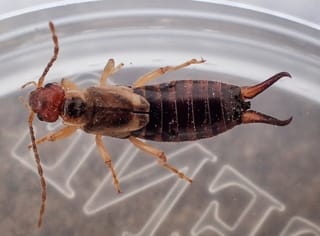  Photo: Philipp Wickey |        Common Earwig, European Earwig(Forficula auricularia, Forficulidae family)Order: Dermaptera (Earwigs) Size: 0.9 - 1.1 in (23 - 28 mm) Distinguishing Features: pair of characteristic forceps-like pincers on the abdomen and membranous wings folded underneath short forewings, though it rarely flies Status: introduced; uncommon Habitat: gardens and grassy areas but will also move into clefts and crevices in homes Despite its common name, this fearsome looking insect does not climb into human ears. The name comes from the look of the hind-wings which when unfolded resemble a human ear. The Common Earwig was introduced into North America in the early twentieth century and has rapidly become a common household insect across the continent. They are considered to be pests due to the amount of damage that they do to crops. Earwigs are omnivorous, hunting at night for other insects and even consuming pantry foodstuffs if in the home. Info Photos |
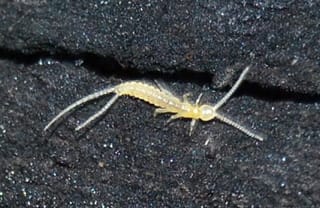  Photo: Andrew Cannizzaro 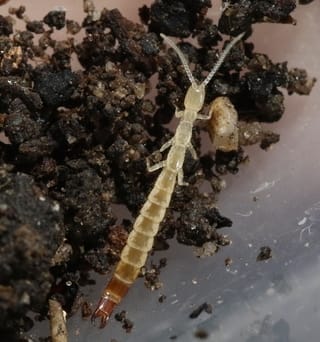  Photo: James Bailey |        Two-pronged Bristletail, Two-tailed Bristletail(Campodeoidea, Japygoidea, and Projapygoidea superfamilies)Order: Diplura (Diplurans) Size: 0.1 - 0.2 in (2 - 5 mm) Distinguishing Features: thin multi-segmented abdomen that is usually white; long, slender antennae; three pairs of walking legs; wingless and eyeless; two prominent rear cerci which are either long and filamentous or short and forcep-like Status: native; common Habitat: in decaying vegetation and damp soil; under logs and rock Two-pronged Bristletails have entognathous mouthparts, meaning that they are enclosed within a pouch in the head capsule. This is the primary feature that distinguishes them and other hexapods in the class Entognatha from those in the class Insecta. About 70 species can be found in North America. Many diplurans eat decaying vegetable matter while some actively hunt small soil-inhabiting arthropods. Yet others are omnivores. Info Photos |
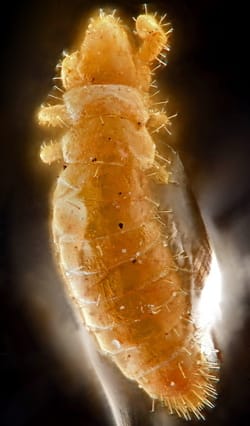  Photo: Edward L. Ruden 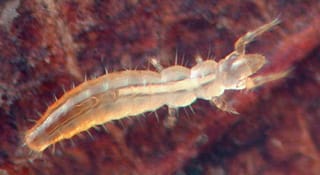  Photo: David R. Maddison |        Conehead(Acerentomata, Eosentomata and Sinentomata families)Order: Protura (Proturans) Size: up to 0.1 in (2 mm) Distinguishing Features: conical head; elongated and cylindrical body that is white or light brown; wingless and eyeless; no antennae or cerci; enlarged forelegs that are held up and serve a sensory function; back four legs used for walking Status: native; common Habitat: in moist soil and leaf mold usually near the surface but may be found much deeper Coneheads, of which there are several hundred species, are relatively new to science as they were only first described in the early 20th century. They, like the others in the class Entognatha, have mouthparts that are largely withdrawn into the head distinguishing them from the Insecta arthropods. Proturans are unique among hexapods in that they add new body segments with each molt, known as anamorphic development. They are thought to feed on decaying vegetation and fungi and thus are considered to play an important role in recycling organic nutrients back into the soil. Info Photos |
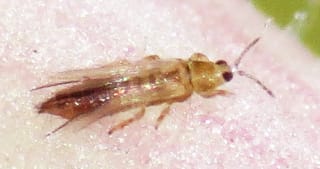  Photo: Chris Mallory 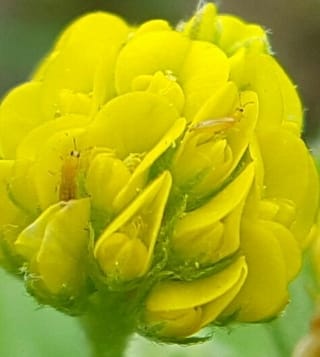  Photo: Kimberlie Sasan |        Thrip(Thripidae family)Order: Thysanoptera (Thrips) Size: up to 0.1 in (1 mm) Distinguishing Features: small cigar-shaped bodies with narrow, fringed wings; yellow to brown or black in color Status: native; common Habitat: on flowers, flowering plants, fruit crops and trees Thrips are thought to be a descendant of fungus-eating insects. Many still feed upon fungi and inadvertently distribute spores. Thrips, unlike true bugs, have asymmetric mouthparts with the right side reduced or almost absent. They feed by cutting into a food plant, injecting saliva to rupture the plant cells and pumping out semi-digested food. The surface of the stems and leaves of plants where they have fed scar over and turn dark leading the group to be considered as pests. A few species even carry various plant viruses. However, some are beneficial as pollinators. Thrips are not strong fliers but rather do what is known as “clap and fling” with their feathery wings to create lift giving them a wobbly pattern. Info Photos |
  Photo: Alex Bairstow |        Silverfish(Lepismatidae family)Order: Zygentoma (Silverfish) Size: 0.5 - 0.8 in (13 - 19 mm) Distinguishing Features: wingless with long antennae and an abdomen that tapers at the end and is gray with a metallic sheen; have a distinctive wiggling movement Status: introduced; common Habitat: moist areas such as in kitchens and bathrooms; rarely seen outside Silverfish are nocturnal insects that have traveled world wide through human movement. They continue to grow and molt throughout their lifetime which can last for several years. Silverfish eat plant-based matter high in carbohydrates and protein such as glue, paste, bookbindings, textiles, flour, cereal and other organic materials. This is reflected in the scientific name of the most common Silverfish, Lepisma saccharina. Consumption and destruction of foodstuffs and property has labeled Silverfish as household and museum pests. Common predators are spiders. Info Photos |
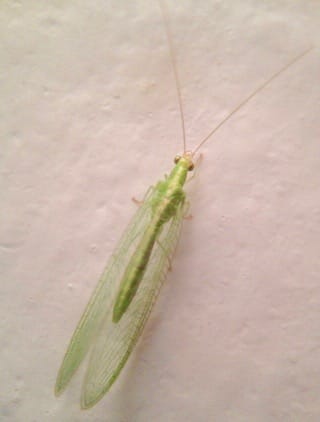  Photo: Scott Pipkin |      Green Lacewing(Chrysopidae family)Order: Neuroptera (Net-winged Insects) Size: 0.3 - 0.4 in (8 - 10 mm) Distinguishing Features: copper-colored eyes and soft bodies; long antennae, and sheer wings Status: native; common Habitat: gardens and other open areas; in summer can be seen around lights Green Lacewings are nocturnal, laying eggs on the underside of leaves. Some adults are predators while others only feed on nectar or pollen. Larvae are voracious predators particularly of aphids thus earning them the nickname of “aphid lion”. They are covered in bristles that collect debris thus providing camouflage against birds. The eggs of some species are being raised as a means of biological pest control. Info Photos |
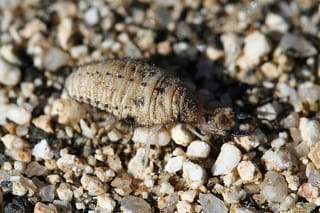  Photo: Ken-ichi Ueda 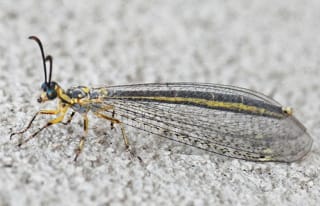  Photo: Jerry Oldenettel |      Antlion, Doodlebug(Myrmeleontidae family)Order: Neuroptera (Net-winged_insects) Size: 0.8 - 1 in (20 - 25 mm) Distinguishing Features: adults resemble a dragonfly with two pairs of long, multiveined, translucent wings and a long, slender abdomen; larvae have a plump abdomen with a flattened head and enormous sickle-like jaws Status: native; uncommon Habitat: sheltered, sandy areas in a variety of places including in flower beds, around hedges and trees and under raised buildings Antlion larvae (Doodlebugs; top photo) of many species live in a funnel-shaped pit in loose material that is used to trap ants and other prey. These ferocious-looking larvae can inject venom and enzymes to immobilize and digest their victims. Adult Antlions (bottom photo) are much bigger than the larvae and can have a wingspan up to 6 in (15 cm). They are typically nocturnal and only live for a few weeks. Info Photos |
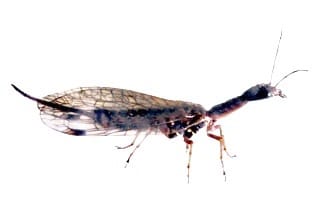  Photo: Graham Mark |      Snakefly(Agulla spp., Raphidiidae family)Order: Raphidioptera (Snakeflies) Size: 0.5 - 1 in (13 - 25 mm) Distinguishing Features: very, long snake-like neck and wings that are longer than its body Status: native; uncommon Habitat: temperate coniferous forests The female Snakefly has a very long ovipositor used to deposit eggs under loose bark and in soil. It is not a stinger. Before the eggs hatch, they can absorb nutrients directly from their surroundings. Both adults and larvae are predacious. Larvae feed on small wood-boring insects and insect eggs. Adults feed on small, weak insects. The adults are short-lived, surviving solely for breeding. Though winged, the adults are weak fliers. Info Photos |
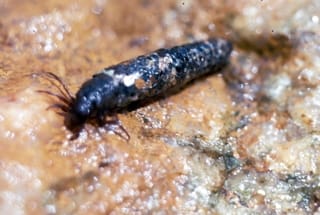  Photo: Howard Ensign Evans 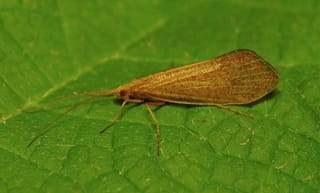  Photo: Kevin Moulton |      Northern Caddisfly(Limnephilidae family)Order: Trichoptera (Caddisflies) Size: 0.8 - 0.9 in (20 - 23 mm) Distinguishing Features: small moth-like insect which is dull in color Status: native; common Habitat: larvae live in water; adults rest on the vegetation near the water Caddisfly larvae (top photos) use silk excreted by salivary glands to build several types of structures. Nets are used to collect food. Cases, which often have twigs and rocks incorporated in them, are used as a mobile home. The silk is also used to build a cocoon in which the larvae pupate. A large number of adults can emerge all at once and engage mostly in mating behavior. They are short-lived and, in general, do not eat. Info Photos |
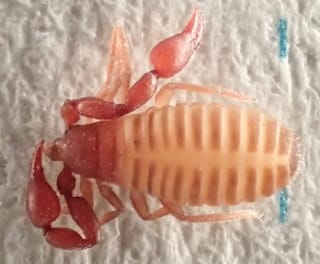  Photo: Phillipp Wickey 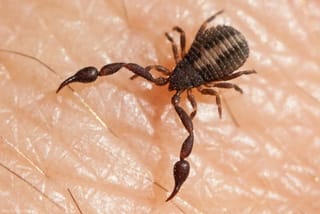  Photo: Ken-ichi Ueda |      Pseudoscorpion, False Scorpion, Book Scorpion(Pseudoscorpiones family)Order: Pseudoscorpiones (Pseudoscorpions) Size: 0.1 - 0.3 in (2 - 8 mm) Distinguishing Features: looks like a tiny scorpion with a short, rounded abdomen, two very long pincers but without a tail or stinger; color varies by species Status: native; common Habitat: leaf litter, decaying vegetation and beneath tree bark; often in homes Pseudoscorpions are so small that they usually go unnoticed despite being common in many places. They are harmless hitchhikers, they often attach themselves to insects and come into homes with their ride. They are generally beneficial to man as they prey on insects like carpet beetles, clothes moth larvae, ants, mites, small flies and booklice. Booklice are the reason these creatures are often found in rooms with dusty books. Pseudoscorpions use their long pincers to catch their prey, inject them with paralyzing venom and pour digestive fluids over them. These tiny arachnids can make cocoons by spinning silk from a gland in their jaws. Info Photos |
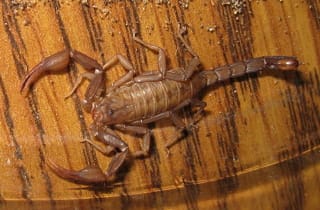  Photo: Jennifer Macke 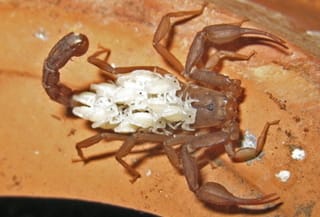  Photo: Jennifer Macke 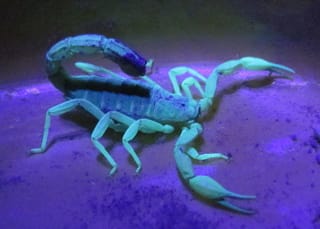  Photo: Randy Johnson |      Scorpion(Vaejovidae family)Order: Scorpiones (Scorpions) Size: 0.8 - 4 in (20 - 102 mm) Distinguishing Features: two large grasping appendages in front; a narrow, segmented tail often carried curved forward over the back with a stinger at the end; coloring, striping as well as size depend on the particular species Status: native; uncommon Habitat: semi-arid areas with warm temperatures under logs, rocks, boards and clutter; some species live underground in burrows, while others may enter homes Scorpions are nocturnal, remaining in sheltered areas during the day to avoid predators and emerging only at night to feed. They are opportunistic hunters primarily catching small arthropods in their pincers and either crushing their prey or injecting venom. There are several different species of scorpion in the local area. These scorpions are not dangerous, though they can deliver a painful sting. The potentially deadly Bark Scorpion is not found in northern New Mexico. Scorpions are ovoviviparous, meaning that the eggs develop inside of the female and the young are born live. After birth the female carries the young with her for awhile (middle photo). Scorpions are know for their ability to glow blue-green under ultraviolet light (bottom photo). Info Photos |
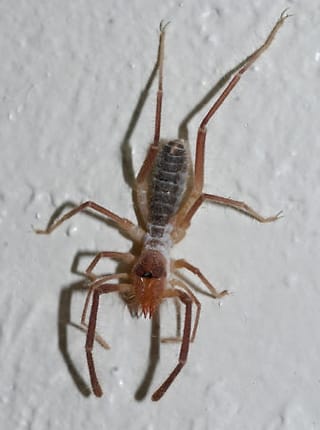  Photo: Sally King |      Windscorpion, Sun Spider; Camel Spider(Solifugae family)Order: Solifugae (Wind Scorpions) Size: 0.4 - 2 in (10 - 51 mm) Distinguishing Features: looks similar to a scorpion or spider with eight true legs, a combined head and thorax, and massive mouth parts but without a tail or ability to make a web; many species have large central eyes Status: native; uncommon Habitat: semidesert, scrub, grassland, forest Windscorpions are neither true scorpion nor spider, though they are more closely related to the former than the latter. They lack the lung-like structures that scorpions and spiders have but rather breathe through three pairs of slits on their underside. Windscorpions are aggressive with a voracious appetite and incredible speed. They primarily feed on ground-dwelling arthropods such as termites and beetles. Once prey is located and captured, a windscorpion will cut it into pieces, liquify it and ingest the liquid material. Windscorpions do not have venom glands or any means of delivering venom but they can deliver a painful bite to a human. Info Photos |
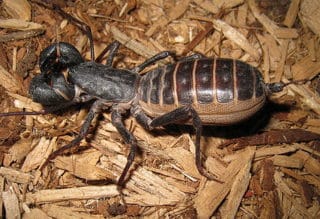  Photo: Jennifer Macke 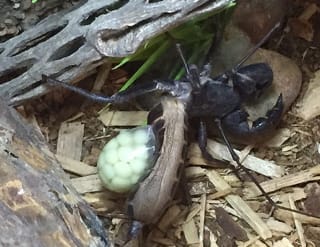  Photo: Jonathan Creel |      Giant Whipscorpion, Giant Vinegaroon(Mastigoproctus giganteus, Thelyphonidae family)Order: Thelyphonida (Whip Scorpions) Size: 1 - 3.5 in (25 - 89 mm) Distinguishing Features: two large claws and two front legs that are held aloft with the remaining six legs used for locomotion; a thin, flexible tail or “whip” extending from the abdomen Status: native; uncommon Habitat: dry areas beneath plant debris, in rock crevices or in burrows Giant Whipscorpions are actually more closely related to spiders than scorpions. Their first pair of legs is carried off the ground and used as sensory organs to detect both chemical and tactile stimuli. They take shelter during the day in burrows that they dig for themselves and come out at night to hunt for insects like cockroaches and crickets as well as other arthropods like millipedes. In order to defend themselves, Giant Whiptail Scorpions can spray a substance what is primarily acetic acid from a gland at the base of the tail. This spray, which gives these whiptails the common name of “vinegaroon”, can cause irritation and pain, especially if one gets it into one’s eyes. Females essentially sacrifice themselves to take care of their young. They literally starve to death by not leaving to feed while the young are unable to fend for themselves (female with egg case, bottom photo). Info Photos |
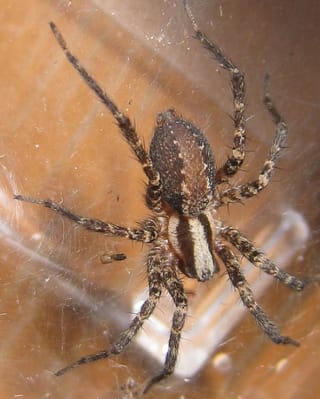  Photo: Jennifer Macke 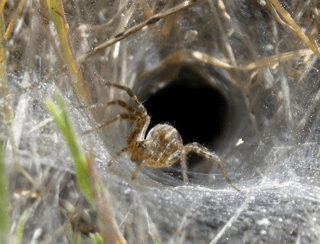  Photo: Donna Walker |                     Grass Spider, Funnel Weaver Spider(Agelenopsis spp., Agelenidae family)Order: Araneae (Spiders) Size: 0.3 - 0.6 in (7 - 16 mm) Distinguishing Features: pear-shaped brown body with two dark bands running down the full length; an elongated abdomen tapering to a point with two visible spinnerets; legs are mottled or stripped depending on the species; males have longer legs than females but all have spines and hairs Status: native; common Habitat: found on or near the ground among grasses or other foliage; in the corners of man-made structures The thirteen species in the genus Agelenopsis have unique but sometimes overlapping geographic distributions and are often very similar in appearance. Grass Spiders as part of the Funnel Weaver family, make very distinctive funnel-shaped webs (bottom photo) which are most often noticed in the early morning when dew has collected. These spiders are nocturnal and very quick moving. A Grass Spider will lay in wait in the web rushing out to grab its prey when detected and then retreating back into the web to eat its catch. These spiders will only bite when threatened. Adults of most species die before winter. Info Photos |
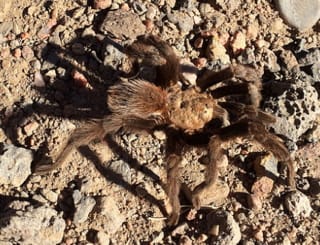  Photo: Jennifer Macke 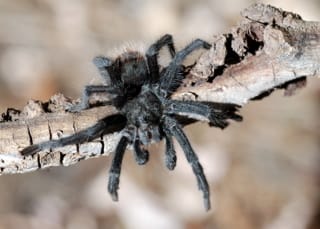  Photo: Sally King, NPS 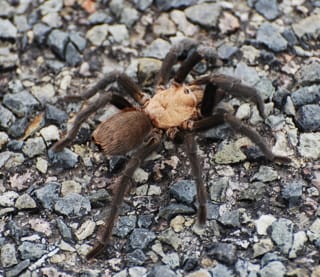  Photo: Jerry Oldenettel |                     Tarantula(Aphonopelma spp., Theraphosidae family)Order: Araneae (Spiders) Size: 1 - 4 in (25 - 102 mm) Distinguishing Features: brown or black hairy, heavy body with long hairy, stout legs several inches long; eight eyes in two groups; backward-pointing "fangs" (chelicerae) below eyes; spinnerets at tip of abdomen; males longer and slimmer than females Status: native; uncommon Habitat: grasslands, scrubland, and desert Tarantulas are the largest spiders in the Southwest. They are rarely seen in most of the area except in autumn when the males leave their burrows in large numbers and seek out females. After mating, the male runs away and the female seals the eggs and sperm in a cocoon. She will then guard it for about two months until the eggs hatch and the spiderlings disperse. Tarantulas primarily eat insects that they hunt for at night. They grab their prey and inject venom to paralyze it. However, they are not dangerous to humans except in the case of a severe allergic reaction. Tarantulas have a defense mechanism where they will kick off the hairs on the back of their abdomen to deter other animals. These hairs are highly irritating. Info Photos |
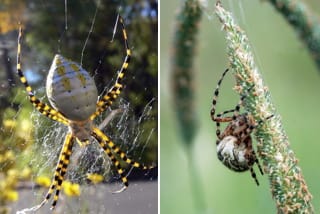  Photo: Sally King, NPS 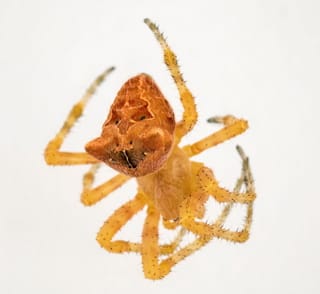  Photo: Mouser Williams   Photo: lewand |                     Orb Weaver(Araneidae family)Order: Araneae (Spiders) Size: 0.2 - 1 in (5 - 25 mm) Distinguishing Features: large rounded body in a range of colors with a small head; thick legs with three claws; most have dark markings; eight eyes in two rows; males are smaller than females Status: native; common Habitat: old fields, grassy areas, gardens Orb Weaver Spiders get their common name from the fact that they spin the classic, round web that one associates with spiders. The photographs show Orb Weavers from several different genera (from left to right and top to bottom): Golden Orb Weaver, Meadow Spider, Cat-faced Spider and Spotted Orb Weaver. Due to a lot of unique features, there is a separate entry in this guide for spiders in the Argiope genus. Many Orb Weavers build a new web each day after consuming the old one. They start with a nonsticky framework followed by a final spiral of silk covered in sticky droplets. They use their third claw to walk on the nonsticky parts of the web. Most Orb Weavers are active in the evening hours. In general they wait for a prey insect to wander into the sticky part of the web, give it a quick bite and then wrap it in silk. In general, males do not spin webs but usually wander to find a female to mate with. Mating in most species usually occurs at the center of the web with the male often eaten after mating occurs. Info Photos |
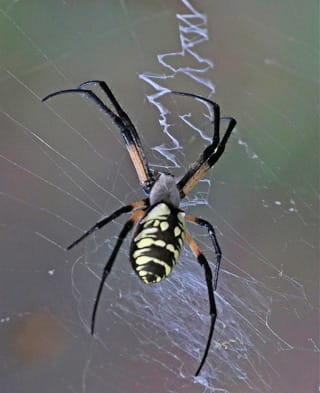  Photo: Jerry Oldenettel 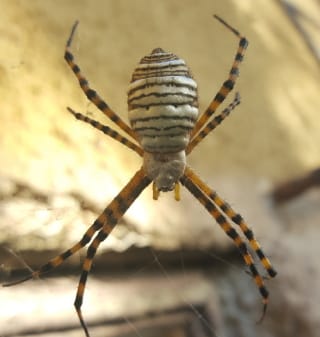  Photo: valerianna7 |                     Garden Spider, Argiope(Argiope spp., Araneidae family)Order: Araneae (Spiders) Size: 0.2 - 1 in (5 - 25 mm) Distinguishing Features: large, brightly colored ovoid body with a small head; thick sprawling legs with three claws; eight eyes in two rows; males are smaller than females and not as brightly marked Status: native; common Habitat: gardens, old fields, grassy areas Garden Spiders are member of the Orb Weaver family specifically belonging to the Argiope genus. Please note that there is a separate entry for a general description of other genera in the Araneidae family. The two Argiope that are common in the area are the Black and Yellow Garden Spider (Argiope aurantia, top photo) and the Banded Garden Spider Argiope trifasciata, bottom photo). These spiders tend to spin their webs in the early morning on plants, grass and even man-made objects typically 3 ft (1 m) off of the ground. A common feature of Garden Spider webs is known as the stabilimentum. This is a crisscross band of silk through the center of the web as seen in the top photo. These bands reflect ultraviolet light and are thought to play a role in attracting prey to the web. Garden Spiders are capable of catching insects up to twice their size. During mating season, the male spins a web close to the female’s. The eggs are placed in a silk sac in the web. Although the eggs hatch in autumn, the spiderlings overwinter and emerge in spring. Theses spiders are not aggressive but will bite if feel threatened. The bite has been described as being comparable to a bee sting. Info Photos |
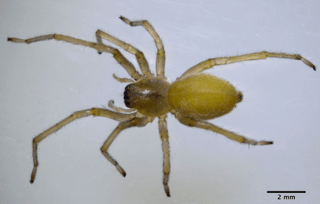  Photo: Don Loarie 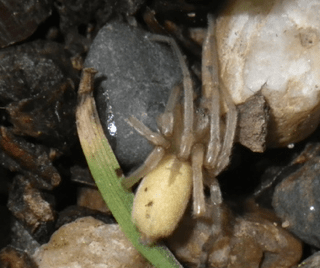  Photo: Dominic |                     Long-legged Sac Spider, Longlegged Sac Spider, Yellow Sac Spider(Cheiracanthium mildei, Cheiracanthium inclusum, Eutichuridae family)Order: Araneae (Spiders) Size: 0.2 - 0.4 in (5 - 10 mm) Distinguishing Features: pale in color with cephalothorax and abdomen roughly the same size and yellow to beige in color; proportionally long legs for body; males have longer legs than females Status: native; uncommon Habitat: scrublands and open fields; often found indoors There are only two species of Long-legged Sac Spiders in the US: Cheiracanthium mildei (top photo) and Cheiracanthium inclusum (bottom photo). Both of these species are colloquially known as Yellow Sac Spiders. These spiders do not spin webs to capture their prey but rather hunt for insects and other invertebrates on foot at night. They do, however, spin a “sleeping bag” for resting in during the day. These retreats can often be found where the ceiling meets a wall. The bite of these spiders can be as painful as a bee sting but no longer is considered to cause skin necrosis as it once was thought. Info Photos |
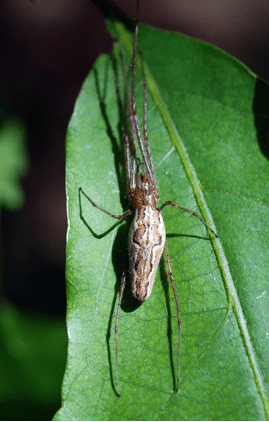  Photo: Sally King, NPS 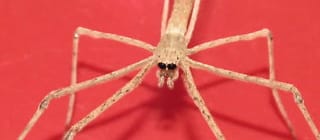  Photo: Ungoliant 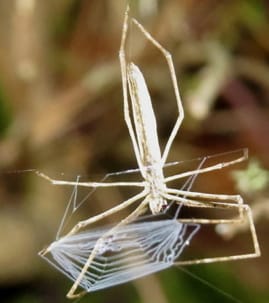  Photo: Ungoliant |                     Ogrefaced Spider, Ogre-faced Spider, Net-casting Spider(Deinopis spp., Deinopidae family)Order: Araneae (Spiders) Size: 0.4 - 0.8 in (10 - 20 mm) Distinguishing Features: camoflaged in shades of brown and black; elongated body with thin legs; eyes arranged in three rows with the two middle eyes extremely large; males smaller than females Status: native; uncommon Habitat: wooded areas Ogrefaced Spiders are so called due to their eye-bulging, ogre-like facial appearance (middle photo). They are part of the Net-casting Spider family which build unusual A-frame shaped webs that are suspend horizontally between the spider’s front legs (bottom photo). When prey comes close, the spider will stretch the net to several times its original size and throw itself onto the prey in order to entangle it in the web. It will then wrap whatever it has caught in silk before injecting it with poison. These spiders will eat a variety of insects (flies, butterflies, beetles, etc.) and other spiders including members of its own species. It is mostly active at night, resting in a hiding place during the day. Info Photos |
Photo: Marshal Hedin 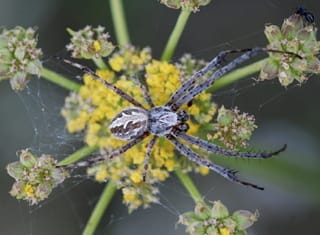  Photo: Sally King, NPS |                     Coneweb Spider, Cone Web Spider, Desert Bush Spider, Desertshrub Spider(Diguetia spp., Diguetidae family)Order: Araneae (Spiders) Size: 0.2 - 0.4 in (5 - 10 mm) Distinguishing Features: hairy with dark bands on abdomen; long legs usually with stripes; six eyes arranged in pairs; sexes similar Status: native; common Habitat: dry areas with shrubs or cacti Coneweb Spiders are named for their distinctive web (top photo) usually found in a bush or shrub or even strung between cacti pads. The spiders construct a doomed sheet topped with a long tube. Plant material is then incorporated into web. The web serves as a retreat and an safe place for the female spider’s egg sac. In addition, these spiders take whatever prey gets caught in the web. There is only one genus of Diguetidae found in the US with a range restricted to the Southwest. The most widely distributed spider in this group is Diguetia canities (top photo). Even though Coneweb Spiders have the same arrangement of six eyes that the Brown Recluse does, they are not harmful. Info Photos |
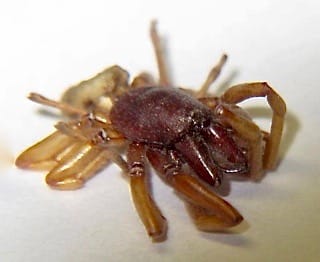  Photo: PEEC 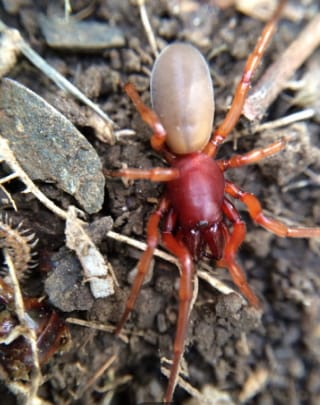  Photo: Brian Palatucci |                     Woodlouse Hunter, Sowbug Hunter, Pillbug Hunter, Sowbug Killer, Pillbug Killer, Stiletto Spider, Slater Spider(Dysdera crocata, Dysderidae family)Order: Araneae (Spiders) Size: 0.4 - 1.2 in (10 - 30 mm) Distinguishing Features: dark-red cephalothorax and legs, shiny yellow-brown abdomen, very large front appendages; males smaller than females Status: introduced; common Habitat: under logs, rocks, leaf litter in warm places; sometimes can be found in houses Dysdera crocata is native to the Mediterranean area but is now spread across the globe via commerce and is the only Woodlouse Hunter species found in the US. These spiders do not spin a web but usually construct a tent-like structure to serve as a daytime retreat. They hunt at night on foot primarily for land isopods (sowbugs and pillbugs). A Woodhouse Hunter uses its large front appendages (chelicerae) to stab through the woodlouse’s soft underbelly and inject venom. It can also tackle other invertebrates in the same manner. These spiders will bite if handled but generally cause no more than localized itching. Info Photos |
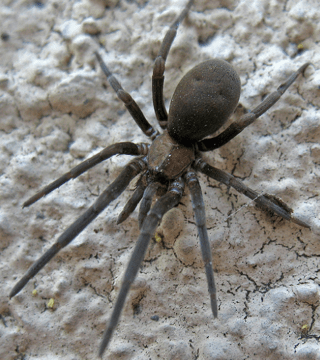  Photo: Ken Schneider 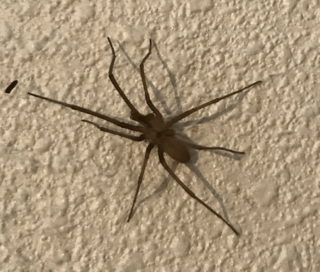  Photo: pgjr75 |                     Crevice Weaver(Filistatidae family)Order: Araneae (Spiders) Size: 0.4 - 1 in (9 - 25 mm) Distinguishing Features: females are black, gray or dark brown with black or dark brown velvety-looking legs; males are light brown and mostly glossy with light brown long legs; males are thinner and smaller than females; both sexes have eight eyes clustered together on a central mound Status: native; common Habitat: cracks and crevices of the exterior of buildings; under stones, loose bark, under logs Female Crevice Weavers (top photo) are rarely seen. They build webs around cracks and seldom move except to capture insect and other arthropod prey. The webbing produced by these spiders is not sticky. Rather they use their legs to comb the webbing and create a fine, velcro-like netting that catches the insects legs. In contrast to females, males (bottom photo) typically wander in search of prey and females to mate with. They do not have a set territory but may stray indoors at times. Male Crevice Weavers can be mistaken for the Brown Recluse (see discussion). However, the Crevice Spider has thick black spines on its legs rather than short wispy hairs, is larger and has no violin shape on its back. A female spider can live for up to eight years and produce several hundred eggs at a time. She will guard an egg sac inside her funnel-like retreat until they have hatched and dispersed. Info Photos |
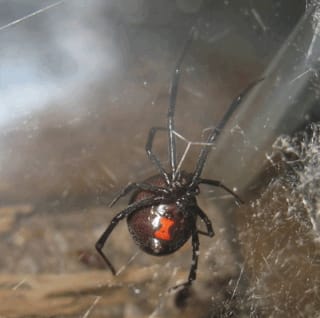  Photo: Jennifer Macke 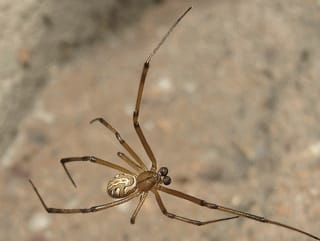  Photo: Davefoc |                     Black Widow Spider, Western Black Widow Spider; Western Widow(Latrodectus hesperus, Theridiidae family)Order: Araneae (Spiders) Size: 0.5 - 1.4 in (13 - 36 mm) Distinguishing Features: female is black with an hourglass-shaped red or orange mark on the lower abdomen; males are about half the size of the female and tan or brown with lighter striping on the abdomen Status: native; common Habitat: hidden under things like ledges and debris as well as in dark areas in dwellings Black Widow Spiders are venomous. However, only the females (top photo) have enough neurotoxin to be harmful; children and the elderly are in the most danger but others may require medical attention. The Black Widow weaves an irregular web from which it hangs and waits until it feels vibrations along silk threads caused by an insect. It then attacks by biting its prey and wrapping it in silk. Specific sexual scents are combined with the web silk and act to stimulate mating when a spider comes into contact with the web of the opposite sex. Although consumption of the males (bottom photo) by females after mating is common for some species, it is rare for Latrodectus hesperus. Info Photos |
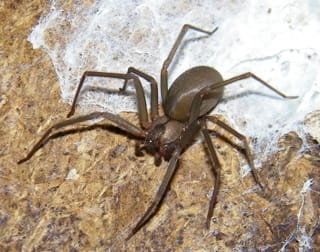  Photo: James W. Beck   Photo: Centers for Disease Control |                     Brown Recluse Spider, Violin Spider, Fiddleback(Loxoscleles reclusa, Sicariidae family)Order: Araneae (Spiders) Size: 0.3 - 0.5 in (7 - 12 mm) Distinguishing Features: tan to dark brown overall; oval abdomen with fine hairs; long legs without spines; violin-shaped mark on back; six eyes arranged in pairs; males have smaller body and longer legs than females Status: not applicable; NOT FOUND IN NORTHERN NM Habitat: dark, dry areas with good places to hide like hollows in trees and rotting logs as well as garages and attics The Brown Recluse Spider is known for the distinctive violin pattern on this back (bottom picture). The diagnostic feature for the Loxosceles genus is the fact that they only have six versus the usual eight eyes. The Brown Recluse is present in southeastern New Mexico. It is not found in the northern part of the state. However, many other brown spiders that are found in the area are mistaken for the Brown Recluse including Crevice Weavers (see discussion). Brown Recluse Spiders can be found all year round in their home range. They construct simple, sheet-like webs covering a crack or cavity for retreat. In general, they do not leave their webs except for mating. The Brown Recluse is one of the few spiders in North America that is truly dangerous. Its bite can range from mild to fatal. Info Photos |
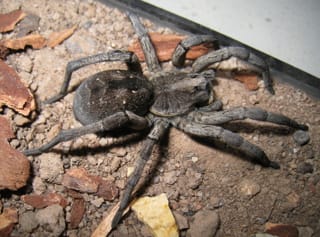  Photo: Jennifer Macke 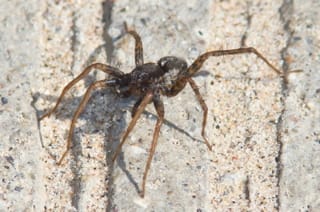  Photo: Greg Lasley 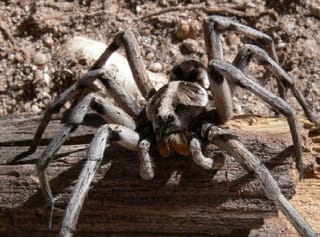  Photo: Sally King, NPS |                     Wolf Spider(Lycosidae family)Order: Araneae (Spiders) Size: 0.1 - 1.4 in (2 - 36 mm) Distinguishing Features: most species are brown to gray in color; males are typically darker than females with more distinct markings and often up to 50% smaller; eight eyes in three rows; long legs with thin spines vary from slender to thick depending on the genus Status: native; common Habitat: found in dry areas like deserts, open fields and pastures; also in decaying vegetation and damp soil, under logs and rocks; edge of water There are at least a dozen different wolf spiders in the local area. The Carolina Wolf Spider (Hogna carolinensis, top photo) is the largest wolf spider in North America. In contrast, the genus Pardosa (Thinlegged Wolf Spiders, middle photo) is represented by some of the smaller wolf spiders in the area. Whereas, Burrowing Wolf Spiders (bottom photo) in the genus Geolycosa are in the middle with respect to size. Wolf Spiders have excellent eyesight and are an agile hunters. They do not spin webs but rather hunt at night, lying in wait for their prey which consists primarily of small arthropods. Most of these spiders live in silk-lined burrows that can be several inches deep. Reproductive behavior is variable with some females living on after mating to lay their eggs the next spring. In other cases, the female spins an egg sac and drags it about until the spiderlings hatch, after which she will carry them on her back until they are ready to disperse. Info Photos |
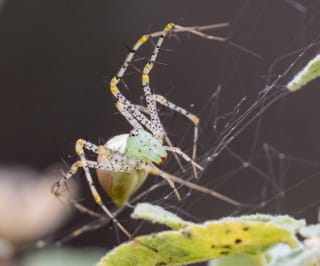  Photo: Greg Lasley 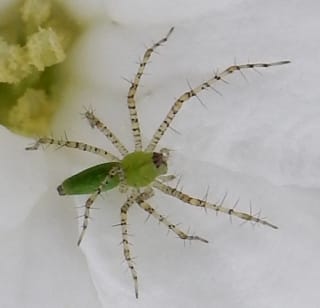  Photo: Bob O'Kennon |                     Green Lynx Spider, Lesser Green Lynx Spider(Peucetia viridans, Peucetia longipalpis , Oxyopidae family)Order: Araneae (Spiders) Size: 0.4 - 0.6 in (10 - 15 mm) Distinguishing Features: pear-shaped green cephothorax; abdomen long and tapered to a point in the back; legs long and thin, longer in males; eight eyes with bottom row consisting of two very small eyes in the middle and two larger ones on the sides, the back row is curved with four eyes Status: native; uncommon Habitat: woody shrubs and low bushes in dry areas; agricultural fields Lynx Spiders are quick and agile like the cat from which they have taken their common name. These spiders do not spin a web for capturing prey but rather sit and wait for insects or other spiders to come near. Alternatively, they may actively stalk their prey, often jumping from branch to branch in pursuit. The Lynx Spider uses its silk for drag lines and egg cases. The two Peuceta species in North America are the Green Lynx (P. viridans, top photo) and the Lesser Green Lynx (P. longipalpis, bottom photo). The latter often goes by the common name of Green Lynx as well. Peuceta spiders have the ability to “spit” venom up to several inches but only do so in self-defense. Info Photos |
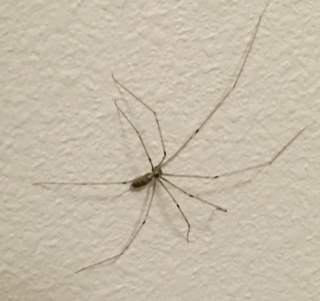  Photo: Jennifer Rycenga |                     Cellar Spider, Daddy Longlegs(Pholcidae family)Order: Araneae (Spiders) Size: 0.2 - 0.3 in (6 - 8 mm) Distinguishing Features: cylindrical, elongated body; very, very long thin and delicate looking legs with three claws; overall grayish-brown with occasional patches of dark gray and beige; eight eyes clustered with three on each side and two in the middle; males slightly smaller than females Status: native; common Habitat: undisturbed place with low light such as basements, under stones and ledges; on ceilings and in corners of buildings Spiders in the family Pholcidae are commonly know as Cellar Spiders or Daddy Longlegs. However, confusion can arise since the latter name is often applied to other arthropods including Harvestmen and Crane Flies. The family contains several hundred species. One of the common Cellar Spiders is the Longbodied Cellar Spider (Pholcus phalangioides, see photo). Spiders in this genus can be found in every continent except Antarctica. Cellar Spiders make large, loose, flat webs in irregular shapes that conform to the surrounding objects. Webs are oriented horizontally and are not sticky. The irregular shape is used to trap insect and other spider prey. Info Photos |
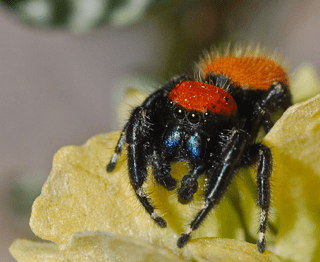  Photo: Sally King, NPS 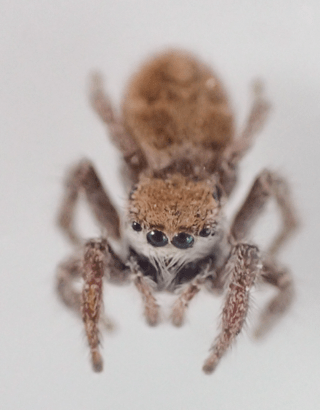  Photo: Philipp Wickey 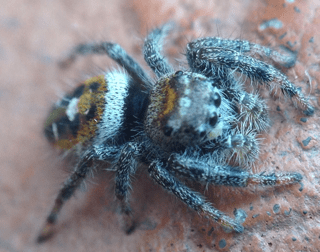  Photo: Scot Pipkin |                     Jumping Spider(Salticidae family)Order: Araneae (Spiders) Size: 0.4 - 1 in (10 - 25 mm) Distinguishing Features: small and very hairy; their “face” is roughly rectangular and flat looking; the front row of four eyes consists of two very large eyes flanked by two smaller ones; the back row consists of four eyes on top of the head (two medium and two small) Status: native; common Habitat: forests, scrublands, mountainous regions Jumping Spiders have a well-developed internal hydraulic system powered by hemolymph that enables them to leap forward. Most species can capable of very agile jumps up to several times their body length. They have excellent eyesight and given the distinctive arrangement of their eyes, they have a near 360-degree view of the world. These spiders are generally diurnal and hunt for insects using a variety of techniques, often moving slowly while stalking prey. They use their silk for a safety line while jumping and as a tether to reach inaccessible prey. In addition, they will build a “pup tent” like web for shelter. These shelters are used to store egg cases and protect the spiders during the winter. Info Photos |
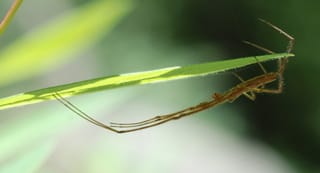  Photo: Sally King, NPS 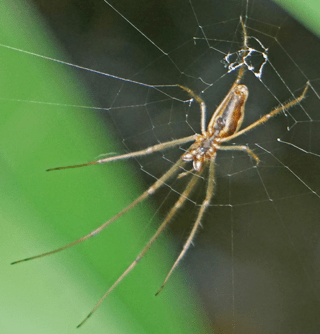  Photo: Emily Hjalmarson 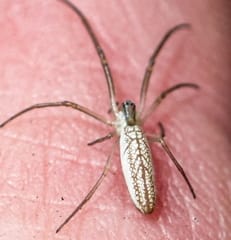  Photo: Philipp Wickey |                     Long-jawed Orb Weaver, Longjawed Orb Weaver, Stretch Spider(Tetragnathidae family)Order: Araneae (Spiders) Size: 0.1 - 0.8 in (2 - 20 mm) Distinguishing Features: varied in appearance but usually have thin, elongated bodies with very long legs; extended chelicerae (jaws) Status: native; common Habitat: riparian; bushy areas and meadows near water The Long-jawed Orb Weavers take advantage of their thin shape to help to camouflage themselves among twigs and small branches (top photo). However, their most distinctive feature is the long appendages or chelicerae in front of the mouth (bottom photo) for which their common name is derived. In some species these fangs are longer than the anterior part of the body. Long-jawed Orb Weavers build circular webs similar to the Orb Weavers in the Araneidae family but without as many spokes. Also they are usually situated parallel to the ground instead of being upright. Both males and females build webs but when they males reach maturity they will go hunt females and will squat on their webs until after mating. Info Photos |
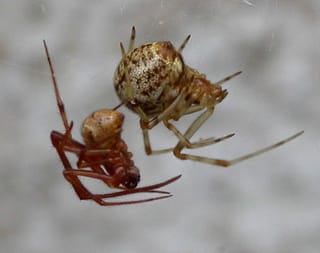  Photo: Calibas 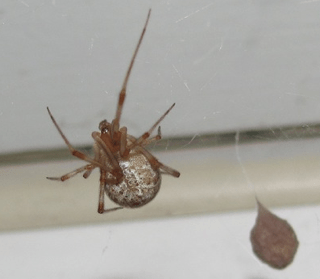  Photo: Chuck Sexton |                     Cobweb Spider, Cob Web Spider, Comb-footed Spider(Theridiidae family)Order: Araneae (Spiders) Size: 0.1 - 0.3 in (3 - 6 mm) Distinguishing Features: dull brown in color with darker brown patterning particularly on the legs that often appears spotted; males much smaller than females Status: native; common Habitat: garages, basements, sheds, woodpiles Cobweb Spiders build webs, often in proximity to each other, in order to trap insect and other invertebrate prey. A male and a female (top photo) may share a web for a considerable length of time. These spiders do not display typical behavior, i.e., males do not roam in spring and females to not seek refuge in fall. Rather both sexes can be found, even in mid-winter, remaining almost motionless on a web waiting until prey is abundant. Cobweb Spiders have poor vision and cannot detect anything more than three to four inches away. They are timid. They will hide behind something like a leaf or drop a silk thread and flee their web if they detect a foe. If cornered, they will feign death as last resort. A single female can produce numerous egg sacks (bottom photo) with hundreds of eggs in each. The young remain with their mother in her web for several days after hatching. Although the common Cobweb Spiders have a similar body shape and size in comparison to Widow Spiders that are also in the Theridiidae family, they are not dangerous and will only bite if grabbed or squeezed. Info Photos |
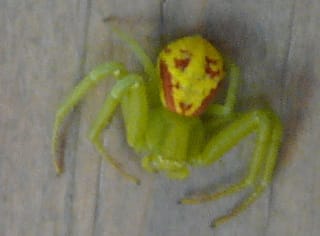 Photo: Rebecca Shankland 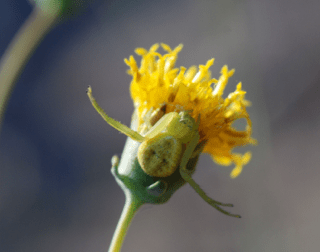  Photo: Sally King, NPS   Photo: Deb Martin |                     Crab Spider, Flower Spider(Thomisidae family)Order: Araneae (Spiders) Size: 0.2 - 0.4 in (4 - 10 mm) Distinguishing Features: wide flattened body that is usually white, pale green or yellow colored; front two pairs of legs are held out to the sides like a "crab"; two rows of four eyes; in some species only six eyes are visible; females bigger than males, can be up to two-fold larger in some species Status: native; common Habitat: gardens, forested areas, scrubland In addition to generally resembling a crab in shape, Crab Spiders can walk sideways and backwards like a crab. These spiders are active during the day and even though they can produce silk for things like drop lines, they do not make webs to trap prey. Instead many species wander in search of insect prey to grab. Many other species are ambush predators, usually waiting near flowers or fruit for insects to come near. They prefer bees, butterflies and flies. Mating takes place in the summer. After the spiders have mated, females makes a cocoon-like casing around the eggs and protect them until they hatch about three weeks later at which point the females die of exhaustion. Crab spiders can bite but are not aggressive and not considered harmful to humans. Info Photos |
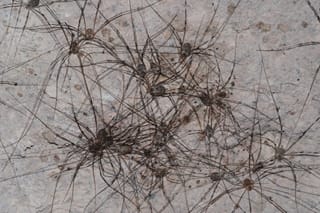  Photo: Sally King, NPS 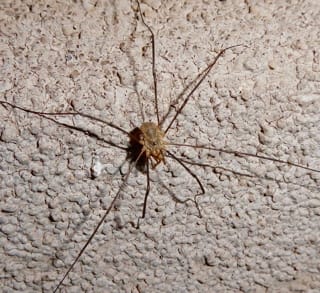  Photo: moabgardener |                     Harvestman, Harvester(Phalangiidae family)Order: Opilione (Harvestmen) Size: 0.2 - 0.4 in (5 - 10 mm) Distinguishing Features: small, single oval body structure; very long legs up to several inches long; the second pair are longer that the others and function as feelers; only two eyes Status: native; common Habitat: moist areas among grasses and leaf litter as well as indoors in cellars Although Harvestmen are arachnids and look to be spiders at first glance, they are not closely related to spiders. There are a large number of different species of native Harvestmen in the area and at least one that may be not native. Harvestmen eat a variety of foods from small insects, arthropods and mollusks to decaying plant and animal material. They are capable of swallowing pieces of solid food rather than just liquids and are fastidious as they will clean their legs by drawing them through their mouths after eating. Despite an ongoing urban legend, Harvestmen do not bite and are not venomous. Their main defense is release of a strong smelling odor. Info Photos |
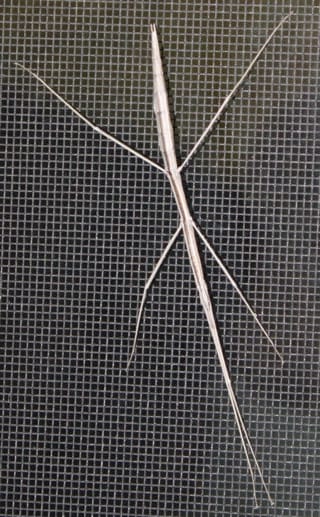  Photo: Akkana Peck |    Short-horn Walkingstick(Parabacillus spp., Heteronemiidae family)Order: Phasmida (Stick Insects) Size: 2 - 6 in (51 - 152 mm) Distinguishing Features: brown body and legs are very long and slender imitating the look of a twig; does not have wings Status: native; uncommon Habitat: seen resting on walls, fences, and other structures After mating, females lay eggs on to the forest floor one at a time where they overwinter in leaf litter to hatch the following year. Walkingsticks undergo incomplete metamorphosis so that when the eggs hatch, small versions of the adults, often called nymphs emerge. The nymphs live in the trees and shrubs eating leaves before undergoing a final molt into the adult form in late summer, thus restarting the mating and egg-laying cycle. Female walkingsticks possess the ability to reproduce by themselves but only produce females by this method. Walkingsticks have the ability to regenerate lost limbs. Info Photos |
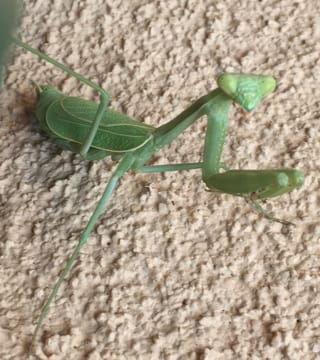  Photo: Pat Bacha 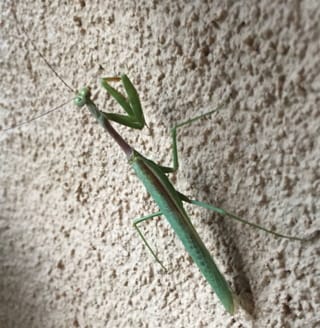  Photo: Pat Bacha |    Praying Mantis(Mantidae family)Order: Mantodea (Mantids) Size: 0.5 - 2.5 in (13 - 64 mm) Distinguishing Features: large insect with a triangular head on a long "neck," or elongated thorax; typically green or brown in color with front legs lifted in a "prayer-like" position Status: native; introduced; uncommon Habitat: hunts in vegetated areas in late summer and early fall Praying Mantises are primarily ambush predators, employing the sit and wait technique of capturing prey. Once spotted, they will stalk their quarry. When ready, they will use their spiked front legs to very quickly grab and hold on to it. Their diet primarily consists of a variety of insects. However, they have very little value as a biological control agent since they are generalists and do not seek out specific pests. In fact, adults have been know to cannibalize younger mantises and even prey on younger hummingbirds. In addition, they can participate in sexual cannibalism, i. e., females (top photo) consuming males (bottom photo) after mating. When threatened, Praying Mantises will rear up and spread their hind wings to scare predators. Females usually do not fly and males only fly for short distances. There are both native and introduced species in the area. Info Photos |
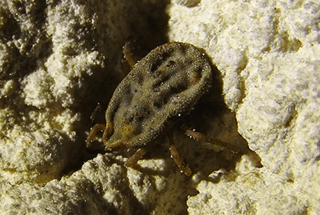  Photo: d_b 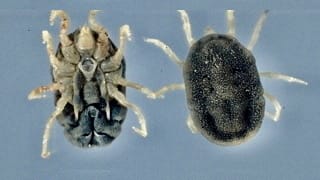  Photo: Jim Occi |      Softbacked Ticks, Soft-backed Tick; Soft Tick(Argasidae family)Order: Ixodida (Ticks) Size: 0.1 - 0.6 in (3 - 15 mm) Distinguishing Features: ovoid body and a soft shield; mouthparts are located on the underside Status: native; common Habitat: sandy areas and in crevices near animal dens or nests; may enter dwellings There are many fewer species of Softbacked Ticks than Hardbacked Ticks and a large number of them feed primarily on the blood of birds. However, many of the Soft Ticks found in New Mexico are of the genus Ornithodoros (top photo) which live as ectoparasites of mammals and can carry tickborne relapsing fever (TBRF). The primary vector at higher altitudes is Ornithodoros hermsi and at lower altitudes is Ornithodoros turicata (ventral and dorsal sides; bottom photo). Transmission of TBRF to humans is often associated with sleeping in rodent-infested cabins. The bite of these ticks is usually very painful and may produce intense irritation and swelling. Softbacked Ticks do not usually stay very long on their hosts. They tend to come out of hiding at night when they smell carbon dioxide in the breath of their hosts. Soft Ticks go through as many as seven nymphal stages and require a blood meal at each stage. Their overall life cycle can take from several months to years. Info Photos |
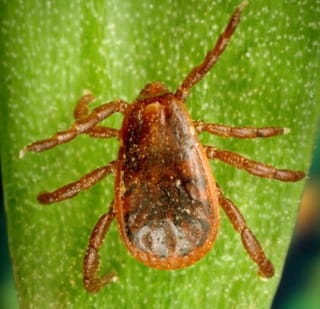  Photo: Anonymous 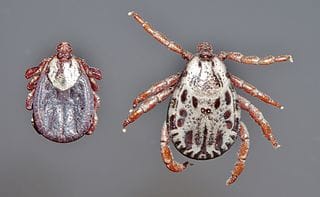  Photo: Daktaridudu |      Hardbacked Tick, Hard-backed Tick; Hard Tick(Ixodidae family)Order: Ixodida (Ticks) Size: 0.1 - 0.5 in (3 - 13 mm) Distinguishing Features: ovoid body, eight legs, prominent mouth and feeding parts and a hard shield Status: native; common Habitat: seen primarily in wooded and remote areas on hosts; some species can develop indoors Hardbacked Ticks, so named for their ability to resist being crushed, are ectoparasites primarily living off of the blood of mammals and birds. They are vectors for a number of diseases such as Rocky Mountain spotted fever, tick paralysis, tularemia, and Lyme disease. Please note that the latter disease is not found in the local area. There are four stages in the life of a Hard Tick — egg, larva, nymph and adult. Development can take up to a year and can involve either one, two or three hosts depending on what stage the tick leaves a host and finds another. Hardbacked Ticks in the area include the Brown Dog Tick (top photo), the Rocky Mountain wood tick (female and male, bottom photo) as well as various Ixodes species. They generally have a painless bite and are not noticed until they are fully engorged. This can take up to several days and is more pronounced in the females to the point that their shorter legs are not easily visible. Info Photos |
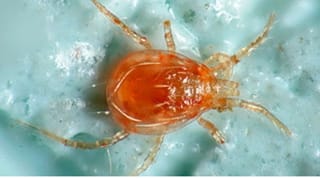  Photo: Natural History Museum, London 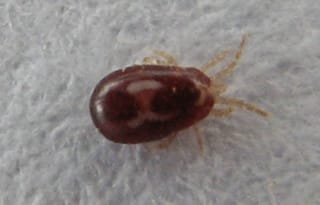  Photo: Furado 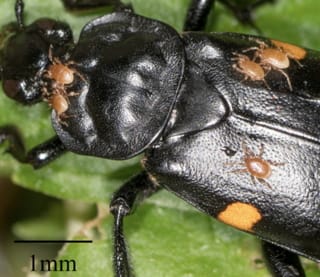  Photo: Jesse Rorabaugh |      Mite (Mesostig)(Arctacarina, Dermanyssiae and Parasitina suborders)Order: Mesostigmata (Parasitiformes Mites) Size: up to 0.1 in (1 mm) Distinguishing Features: tick-like with a single pair of lateral respiratory openings (spiracles); usually have long legs Status: native; common Habitat: parasites on invertebrates and vertebrates; many are free-living predators in soil and debris Although some Mesotig mites are parasitic, most of these tick-like mites are predatory. The largest family of free-living mites (Phytoseiidae) primarily feeds on small arthropods and nematodes. As such, they are often used as biological control agents, e.g.,Neoselulus californians and Phytoseiulus persimilis (top photo) with the latter introduced in the US to control spider mites. The Dermanyssidae family includes a large number of parasitic mite species which live on the blood of different mammals and birds. In particular, Dermanyssus gallinae (middle photo, red poultry mite) is one of the most economically important ectoparasites for its impact on the poultry business. In general these mites do not live for more than three weeks without blood from a bird. However, in the absence of the proper host, they will bite humans. The saliva they inject can cause severe itching and a rash. Other medically important parasitic mites can be found on bats (Macronyssidae family) and rodents (Laelapidae family). Invertebrates are not immune to parasitism by Mesotig mites. Mites in several different families such as Pasasitidae, Discozerconidae and Varroidae attack a variety of insects (bottom photo) including bees. Info Photos |
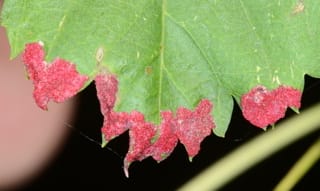  Photo: Don Loarie 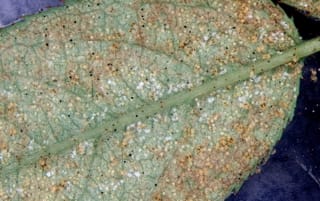  Photo: Whitney Cranshaw 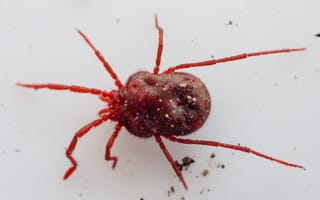  Photo: Phillip Wickey |      Mite (Prostig)(Prostigmata suborder)Order: Trombidiformes (Acariformes Mites) Size: up to 0.2 in (4 mm) Distinguishing Features: rounded shape with anterior respiratory openings (stigmata) and piercing front appendages (chelicerae) Status: native; common Habitat: most live as parasites on plants; others are parasites on invertebrates and vertebrates; some are free-living predators in soil and debris The Prostig mites are part of the Acariformes superorder of “true mites” which contains hundreds of thousands of extremely diverse species. Several families of these mites are best known for being plant parasites and as such are generally considered to be major pests. These common, near microscopic mites, are generally known as gall mites (top photo, Eriophyidae) or spider mites (middle photo, Tetranychidae), some of which even spin silk webbing. In contrast, a different family of mites (Demodicidae) live in or near mammalian hair follicles. In general, these mites do not typically cause symptoms but can be responsible for diseases such as mange in weakened animals. Still other mites like those in the Erythraeidae family (bottom photo), including the velvet mites, are free living predators of small invertebrates; while those in the Trombiculidae family feed on skin cells from animal hosts as larvae and on plants as adults. This latter group includes harvest mites and chiggers. The chiggers in New Mexico almost exclusively feed on rodents and leave humans alone. Info Photos |
